
About UsThe Numismatic Bibliomania Society is a non-profit organization devoted to the study and enjoyment of numismatic literature. For more information please see our web site at coinbooks.org SubscriptionsThose wishing to become new E-Sylum subscribers (or wishing to Unsubscribe) can go to the following web page link MembershipThere is a membership application available on the web site Membership Application To join, print the application and return it with your check to the address printed on the application. Membership is only $20 to addresses in the U.S., $25 for First Class mail, and $30 elsewhere. For those without web access, write to: David M. Sundman, Treasurer
AsylumFor Asylum mailing address changes and other membership questions, contact David at this email address: dsundman@LittletonCoin.com SubmissionsTo submit items for publication in The E-Sylum, just Reply to this message, or write to the Editor at this address: whomren@gmail.com BUY THE BOOK BEFORE THE COINSale Calendar |
- WAYNE'S WORDS: THE E-SYLUM SEPTEMBER 20, 2015
- CHARLES DAVIS SEPTEMBER 12, 2015 SALE RESULTS
- BALDWIN'S PROSPERO LIBRARY CATALOG AVAILABLE
- NEW BOOK: HISTORY OF MEDIEVAL COINAGE IN ENGLAND
- BOOK REVIEW: ABEL BUELL AND THE CONNECTICUT AND FUGIO COINAGES
- BOOK REVIEW: LINCOLN’S METALLIC IMAGERY
- ANS DIGITAL LIBRARY ANNOUNCED
- OCTOBER 2015 PAN SHOW LECTURE SERIES SPEAKERS
- NOTES FROM E-SYLUM READERS: SEPTEMBER 20, 2015
- ANSWERS: DENOMINATIONS NAMED AFTER PEOPLE
- MACOMB MEDAL JUST ONE HIGHLIGHT OF SALE
- COUNTERFEITING AND 1817/4 OVERDATE BUST HALVES
- QUERY: ARTIST NICHOLAS GEVELOT INFORMATION SOUGHT
- ISAAC FRANCIS WOOD (1841-1895)
- THIAN MASTER CONFEDERATE CURRENCY ALBUM OFFERED
- DESIGNING THE PEACE DOLLAR
- BURNS MEMORIAL REFERENCE LIBRARY DEDICATION
- THE DYING ART OF THE OBITUARY
- SWEDEN'S BLODSKLIPPINGAR OR 'BLOOD KLIPPE'
- EXHIBIT: THE SUN KING AND THE PRINCES OF MONACO
- AN 1839 VICTORIA PROOF SET
- NUMISMATIC TOUR OF CUBA PLANNED
- ARTIST INCORPORATED SIGNATURE INTO SCOTTISH BANKNOTE
- THE VIMY MEMORIAL ON THE NEW CANADIAN $20 BILL
- BOMBAY HOOK WILDLIFE REFUGE QUARTER LAUNCH
- THE H.L. HUNLEY LOOKS LIKE A SUBMARINE AGAIN
- SOME RECENT COIN DESIGNS: SEPTEMBER 20, 2015
- ARTICLE PROFILES BROTHERS IN CANADIAN MINT'S DESIGN CONTEST
- TREASURE HUNTING IS THE SCHMITT FAMILY BUSINESS
- SELECTIONS FROM THE ERIC P. NEWMAN COLLECTION PART VII
- EARLIEST MONEY USING THE DOLLAR AS A UNIT OF VALUE
- NEW EXHIBIT OF ST ALBANS ROMAN COIN HOARD
- PROTECTING PAPER OBJECTS IN CORNERSTONES
- FEATURED WEB SITE: NOTRE DAME COLONIAL CURRENCY
Click here to access the complete archive
To comment or submit articles, reply to whomren@gmail.com
WAYNE'S WORDS: THE E-SYLUM SEPTEMBER 20, 2015

New subscribers this week include: Wolfgang Schuster. Welcome aboard! We now have 1,880 subscribers.
This week we open with the results of Charlie Davis' recent literature sale, Baldwin's Prospero fixed price list, one new book and two reviews.
Other topics include Medieval and pre-decimal coinage in England, denominations named after people, Colonial currency, Confederate currency, submarines and teenaged vixen, the Peace dollar, and the Bombay Hook quarter.
To learn more about the ANS Digital Library, coiner Abel Buell, numismatist Isaac Francis Wood, artist Nicholas Genvelot, the treasure-hunting Schmitt family, coin press makers Morgan & Orr, Thian's currency album, Blood Klippe, and Charlie Chaplin tokens, read on. Have a great week, everyone!
Wayne Homren
Editor, The E-Sylum
CHARLES DAVIS SEPTEMBER 12, 2015 SALE RESULTS
 Our mail bid sale of September 12 was quite successful, raising a little over $150,000. Comprised of the Charles Horning Collection of
Bangs catalogues, a fine ancient and medieval library from Newport RI, and numerous early American plated catalogues, there was substantial interest
in all sections of the catalogue.
Our mail bid sale of September 12 was quite successful, raising a little over $150,000. Comprised of the Charles Horning Collection of
Bangs catalogues, a fine ancient and medieval library from Newport RI, and numerous early American plated catalogues, there was substantial interest
in all sections of the catalogue.
It was gratifying to see that no fewer than 20 individuals won at least one of Charlie's Bangs catalogues, some of which had not been seen in 20 years.
The prices paid for seldom offered Chapmans showed that they are the bellwether of the market. The Henderson catalogue with its four plates brought $9,487.50, Bascomb & Brown $3,737.50 and Taylor-Windle at $2,990. Even the oft offered Stickney, bidding perhaps stimulated by the inclusion in our catalogue of previously unpublished notes on his relationship with the U.S. Mint, brought $2,875
 The unbound Crosby Early Coins of America, quite rare in its original wrappers, may be considered a bargain at $7,187.50.
The unbound Crosby Early Coins of America, quite rare in its original wrappers, may be considered a bargain at $7,187.50.
In the ancient section, Greek fared better than Roman with the catalogues of Jacob Hirsch receiving more bids than any lot in any section of the catalogue. A long bound run of the early issues of the Numismatic Chronicles, ex Harvard College, brought $6,900
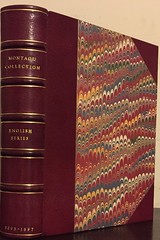 A handsome priced and named Sotheby's Montagu Collection of English Coins realized $2,645.
A handsome priced and named Sotheby's Montagu Collection of English Coins realized $2,645.
Catalogues and the price list may be obtained by writing to Charles Davis at Numislit@aol.com
Charles Davis
P.O. Box 1
Wenham, MA 01984
Tel: (978) 468 2933
Fax: (978) 468 7893
To read the earlier E-Sylum article, see:
CHARLES DAVIS SALE CLOSES SEPTEMBER 12, 2015
(www.coinbooks.org/esylum_v18n30a03.html)
BALDWIN'S PROSPERO LIBRARY CATALOG AVAILABLE
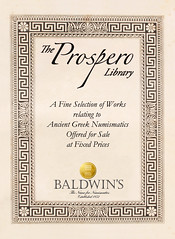 Reference books are the foundation blocks upon which great collections are built. Without these carefully researched works, many completed
after a lifetime's study, the understanding of coins, and by association their value - historic, social, economic, artistic and monetary - would
be lost.
Reference books are the foundation blocks upon which great collections are built. Without these carefully researched works, many completed
after a lifetime's study, the understanding of coins, and by association their value - historic, social, economic, artistic and monetary - would
be lost.
The Prospero library focusses solely on Greek numismatics and as such contains many of the most important catalogues and references written on this vast and fascinating area. In terms of quality, the Prospero library is utterly unsurpassed.
The vast majority of the books have been carefully and beautifully bound. Some originally, but many recently, with a large proportion by that great renowned bindery Sangorski and Sutcliffe, London's oldest and most prestigious bookbinders.
Most of the major reference books published during the last century or more relating to the coinage of Magna Grecia, mainland Greece and Asia Minor are included here, and many of the lesser known and inexpensive titles have been given the same lavish treatment.
The books within this unique catalogue present the collector with a wonderful opportunity to add to their own burgeoning library, and for all of those who have not yet begun represents a fantastic place to start the wonderful journey of building a library of their own.
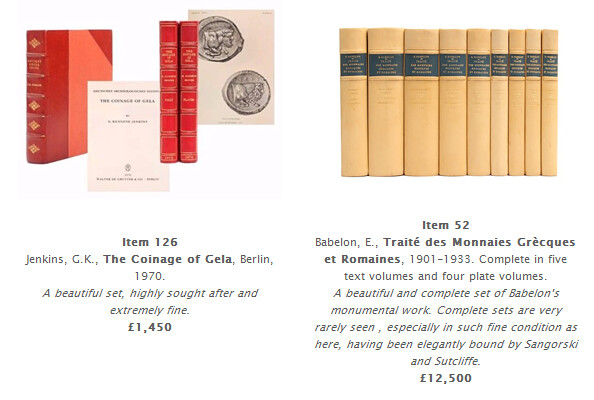
To view the full Prospero Library Fixed Price List, see:
THE PROSPERO LIBRARY
(www.baldwin.co.uk/prosperolibraryfixedpricelist/)
To read the earlier E-Sylum article, see:
BALDWIN'S TO SELL THE PROSPERO LIBRARY IN 2015
(www.coinbooks.org/esylum_v18n32a05.html)
NEW BOOK: HISTORY OF MEDIEVAL COINAGE IN ENGLAND
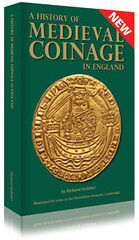 This book is an excellent reference guide to identifying medieval coins. Containing over 530 beautiful colour photographs together with a
comprehensive listing of mints, moneyers and denominations for all English and Irish coins struck between 1066 and 1489.
This book is an excellent reference guide to identifying medieval coins. Containing over 530 beautiful colour photographs together with a
comprehensive listing of mints, moneyers and denominations for all English and Irish coins struck between 1066 and 1489.
A History of Medieval Coinage in England provides an illustrated guide to the coinage of medieval England from the Norman Conquest of 1066 to the reign of the first Tudor king, Henry VII.
While providing guidance on identification this book also places coinage in its historical context and gives insight into how coins were manufactured, used in circulation and lost or buried in a hoard. It is illustrated by more than 530 colour photographs, as well as 125 distribution maps, tables and images of places and people which help bring to life the medieval world in which coins were used and lost.
216 pages, A4, Over 530 coins photographed, showing both obverse & reverse for each coin.

For more information, or to order, see:
A History of Medieval Coinage in England by Richard
Kelleher (www.greenlightpublishing.com/PBSCCatalog.asp?ItmID=18099860)
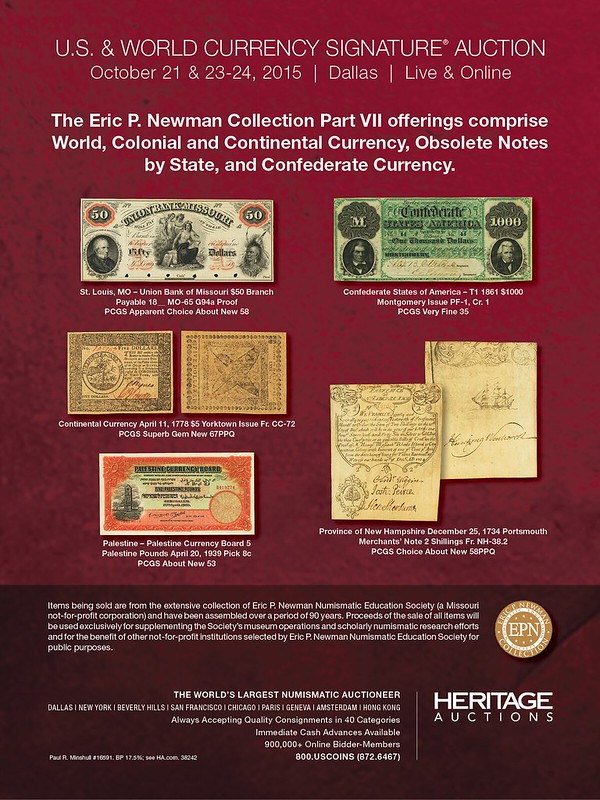
BOOK REVIEW: ABEL BUELL AND THE CONNECTICUT AND FUGIO COINAGES
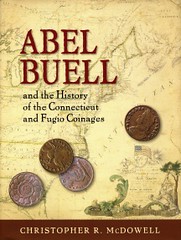 Abel Buell and the History of the Connecticut and Fugio Coinages is Christopher McDowell’s first numismatic book, but he is no
stranger to numismatic writing or Connecticut coppers.
Abel Buell and the History of the Connecticut and Fugio Coinages is Christopher McDowell’s first numismatic book, but he is no
stranger to numismatic writing or Connecticut coppers.
McDowell deftly handles each of the areas Connecticut’s Abel Buell (1742 to 1822) was involved in as a professional: counterfeiting, silversmithing, cartography, type-founding, cutlery, cotton spinning, and minting.
Leaning on primary sources to tell Buell’s remarkable story, this book profitably interweaves secondary material from both well regarded academic sources and the sorts of old historical works that add spice to a narrative despite the need to read them with a skeptical mind.
Walking the line between trusting such sources and abandoning them altogether, Abel Buell and the History of the Connecticut and Fugio Coinages’ use of these old tales lends a dramatic flair to a life story that would be rendered much less interesting without them.
While coin-related history doesn’t appear until 79 pages into the book’s 216-page main text, numismatists will enjoy the stories of Buell’s youthful brush with the law when he was caught raising the value of paper money, as well as his experiences as an engraver of prints and maps, his profiteering from the growing foment of the American Revolution, his pioneering role in the American production of type for printing, his work creating swords of now-legendary rarity, and more.
In fact, the more numismatists understand about allied fields such as copperplate engraving, sword cutlery, and type founding, the better their understanding of manufacturing coins and paper money will become.
They may even find the pull of collecting other sorts of 18th century Americana irresistible. I just hope they have a spouse as understanding as mine when 18th century maps and swords start showing up at home.
Abel Buell’s involvement with the Connecticut and Fugio coinages has been given a masterful treatment, bringing the work of other researchers such as Damon Douglas, Walter Breen, Sylvester Crosby, and others together with new data in a way that will render this book the final word for years to come.
To read the complete article, see:
Book captures Abel
Buell’s legacy: Colonial America
(www.coinworld.com/news/us-coins/2015/09/new-reference-captures-colonial-coin-legacy-of-abel-buell.html)
BOOK REVIEW: LINCOLN’S METALLIC IMAGERY
of Lincoln, Coins, Tokens, Medals, and Plaques.
First Edition, 2015. By Paul Cunningham,
Reviewed by John and Nancy Wilson, NLG
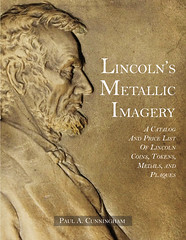 This reference is hardbound and contains 405 pages. The 37 topical chapters contain 354 pages and have more than 3200 pieces cataloged with
their price ranges. The reference has hundreds of illustrations (or images) which are in vivid color. Many have been enlarged for better viewing. The
Lincoln metallic examples found in the book cover the period from 1860 to present. A conversion guide from King to Cunningham will be found in the
back of the reference.
This reference is hardbound and contains 405 pages. The 37 topical chapters contain 354 pages and have more than 3200 pieces cataloged with
their price ranges. The reference has hundreds of illustrations (or images) which are in vivid color. Many have been enlarged for better viewing. The
Lincoln metallic examples found in the book cover the period from 1860 to present. A conversion guide from King to Cunningham will be found in the
back of the reference.
The Foreword, by Clifford Mishler, gives an important overview, analysis and importance of this new Cunningham book. Cliff mentions that the author had, “the assistance and cooperation of nearly 100 fellow enthusiasts, collectors and experts of varying degrees.” He explained that Paul Cunningham didn’t just assemble information “standing on the shoulders of those who came before,” but he “delved into every nook and cranny,” to find material for this reference. Cliff finishes by saying this “truly once in a lifetime publication,” should be in the library of every enthusiast.
The Introduction states that according to Fred Reed lll, some 20,000 books have been written about Lincoln or some aspect of his life. When it comes to valuing the metallic issues of Lincoln nothing compares to this reference. The first expert on Lincoln was the 1900s cataloger Robert P. King, of Erie, PA.
Metals and Alloys: This section contains the abbreviations for the 31 different metallic items, along with the value guide, with price ranges from: A $2 - $5, right up to S for Speculative and U for Unknown. As a pricing guide for Lincoln metallic items this is an important reference to have in your library.
The Acknowledgements read like a Who’s, Who in the numismatic hobby, with a special recognition for Fred Reed lll and a few others.
Chapter 1 covers, First Campaign, 1860, Political Tokens and Medals. The first item listed is a Wide Awakes between two circles inside the rim / Abraham Lincoln around the top inside of the inner circle and nude, beardless bust to right and 1860. Reverse in blank. It is in the shape of a five pointed star. The price is listed as speculative. Captain Zabriskie, who was interested in the piece, in 1880 bid $2 for the piece, but lost to a bid of $42. When that collection was sold Zabriskie purchased this same piece for $1.25. In 1999, Sotheby’s sold this Zabriskie piece for $12,000, on an estimate of $6,000 - $9,000.
Chapters 2, 3 and 4 covers respectively First Campaign – Ferrotypes, Second Campaign – 1864 Political Tokens and Medals and finally Portrait Badges. Ferrotypes are very scarce with values $1,000 -$1,250 to Speculative. Some interesting and rare examples are illustrated. Portrait Badges is an interesting chapter and we particularly liked the story on John Gault and his enterprises including making Ferrotypes.
Chapter 5 covers Civil War tokens that depict Lincoln. We own the plate piece in this book 5-460S (Fuld 045A-1f) which is an R-10 silver Scorecard from Baraboo, WI. The token is ex John Ford collection and we purchased it in a StacksBowers auction in Chicago. The author has it as a value of $3000 - $4000 which is pretty accurate. Mr. Ford was an avid collector of Storecards that portrayed President’s. The popular Wealth of the South Series that depict Lincoln is explained nicely by Q. David Bowers.
Chapter 6 covers Medals of the Civil War is only a few pages long and we thought many more medals would have been made which depicted Lincoln. The author states that Mr. Lincoln is the most written about U. S. President; and falls within the top five of all leaders of humanity. The author also says that this book is, “a drop in the ocean of Lincoln paraphernalia, however a complete index of this sort has never been attempted.” He lists some numbers: 15,000 (approximate) of Lincoln books; 4880 number of listings in this book; 1617 photos; 1210 listings in King Book and eight number of years in this books production and other listings.
There are chapters on: Emancipation proclamation medals, mortuary and death medals, conventions and anniversaries, Franklin Mint medals, US coins with Lincoln on them, world coins picturing Lincoln, as well as medals of service organizations, Masonic and fraternal pieces. You will find in Chapter Nine an interesting story on the gold medal presented to Mary Lincoln by the French Government. Lincoln’s son Robert donated this medal to the Library of Congress. The French letter to Mrs. Lincoln and her acknowledgement are reprinted in this book.
Chapter 10 covers the Thomas L. Elder (1874 – 1948) thirty medals of Lincoln starting in 1909. The author considered Elder the “King of Lincoln tokens.”
Chapter 11, 12 and 13 cover respectively Lincoln Centennial, Sesquicentennial and Bicentennial Issues.
Chapter Fourteen covers Miscellaneous Conventions and Anniversaries. We have some of these items in our collection and find it an inexpensive way to collect Mr. Lincoln
Chapter Fifteen covers Lincoln Coins in the United States. Besides the many common Lincoln coins issued, the chapter has some great pattern coins listed and priced. One such pattern is 15-040CN which is Judd No. 1930 and dated 1909. Coins made of several materials were tested, but only this one is known to exist. It is 19 MM and Copper-nickel with a value of S (Speculative). The biography of Victor D. Brenner is also very interesting.
Chapter Seventeen covers in 11 pages the Medals of Service Organizations. We can now catalog our VFW and American Legion medals.
Chapter Eighteen covers Masonic and Fraternal Pocket Pennies and Medals. It is hard to find any collector who doesn’t have some of these in their collection.
Chapter 20 covers Medals struck for Exposition and Worlds’ Fairs. Interestingly the 1904 St. Louis World’s Fair issued a matchbox depicting Washington, Columbus and Lincoln. Cataloged as 20-190B it has a D value $25 - $50. Amazingly, Robert Hendershott (1898 – 2005) didn’t have this example in his 1904 St. Louis World’s Fair reference published in 1994. As a young boy Bob attended the fair and became an avid collector of the items that were issued. His major collection of the 1904 St. Louis World’s Fair items was sold in St. Louis in the early 2000s. This site will tell you about Bob and his affection with the 1904 World’s Fair and much more: http://webpages.charter.net/mtruax/1904wf/WF_Mem-Hendershott.htm .
Chapter 21 covers Medals Struck for State, County, and Local Fairs. With only one page covering five items the author will receive more listings as collectors and dealers review this reference.
Chapter 22 covers Medals Issued by the United States Mint and otherwise attributed. A great chapter with some fantastic information from Mr. Cunningham, along with Robert Julian, who authored the reference on, Medals of the U. S. Mint regarding how to tell the difference on original issues and restrikes. If you ever wondered why there wasn’t any Assay Medal produced in 1994 the information will be found here.
Chapter 23 covers Souvenir “Pennies” and Other Souvenirs. The author says these large souvenirs will be about 74mm in diameter and will be copper plated. The author challenges future catalogers “to sort out these souvenir pennies and pair them up with the correct reverses and assign makers to each.”
Chapter 24 covers Plaques and contains 36 pages. A “Short History of the Medallic Art Company” is informative. We like the quote found in the item listed as No. 24-1600Bz (1205). It reads, “I cannot conceive how a man could look up into the heavens and say there is no God.”
Chapters 25, 26 & 27 cover respectively Presidential Series of Play Money, Gift Tokens, Etc; Elongated Coins and Mount Rushmore. Incidentally, we have made a special elongated that has a great image of Lincoln that celebrates the 124th ANA World’s Fair of Money. We have a few left over from the ANA Banquet which are on a Jefferson Nickel and will send one to any reader of this review who signs up a junior member in the American Numismatic Association – cost $14 www.money.org or donates one to the Association for them to sign one up using your member number. Let us know at johnancyw@aol.com. The list goes on with store cards, transportation and other advertising tokens.
Chapter 28 covers Store Cards, Transportation, and Other Advertising Tokens. Another large chapter that is arranged alphabetically by “state and city and have some kind of commercial focus.”
Chapter 29 covers Bolen, Kline, Woodward and Merriam Copies and Mulings. Many collectors have “Lincoln” items in their collections produced by Bolen, Kline and Woodward.
Chapters 30 through 34 cover Miscellaneous including Legend Regarding Lincoln; A, Abe, Abraham Lincoln; Sculptors and Makers; No Legend & Jetons used in America. Information on, “The Franklin Mint – The Little Mint That Could,” will be found here.
Chapter 35 covers Non-Metallic Lincoln Items which include, cardboard, plastic, stone or some other non-metallic substance.
Chapter 37 covers Copies, Facsimiles, Fakes, Fantasies and Reproductions. The author mentions that the reproduction of Lincoln “copies and fakes” has picked up recently. Many Lincoln historical sites produce them and we suggest you purchase them because you like them, and not for resale value.
The Bibliography will help the researcher; collector and dealer find other sources for Lincoln. The Conversion Chart from King to Cunningham assists those who have that reference. The Index closes out the reference.
We covered many important chapters in the book, which we feel the majority of collectors and dealers will find most useful. The chapters we didn’t cover would also be useful information to the hardcore collector (or dealer) of Lincoln metallic items. Cunningham also gives many interesting facts concerning Lincoln and his life. We found the book very interesting and informative. We cannot think of anything the author missed pertaining to “Metallic” items that would pertain to Mr. Lincoln. The author mentions that “he hopes you enjoy this book and you appreciate the amount of work that went into gathering material and photographs, rearranging listings and developing a value system that may, truth be told, only last until next year.” In the past several years we have reviewed two Fred Reed lll references on Lincoln. We think that this reference, which has a value guide, and chronologically lists all the items the author has found in “every nook and cranny,” would be a great addition to everyone’s library.
This is quite an outstanding reference with lists of organizations and institutions which will help you’re collecting of Lincoln items. We find it hard to believe that Paul Cunningham, who has dedicated his life to numismatics as a dealer and dedicated worker for the Tokens and Medals Society, the Civil War Tokens Society and other organizations has found time to produce such an outstanding reference.
If you would like to purchase Lincoln’s Metallic Imagery, it is available from the author, with free shipping for $90, or 3 Copies $70, or 3 to 8 Copies for $63, or case price 2 to 5 for $56 (all per book). For more information or ordering you can write to Paul Cunningham, P. O. Box 1, Tecumseh, MI 49286 or Email cunninghamchips@hotmail.com or visit the Cunningham web page at http://www.cunninghamexonumia.com/ .
To read the earlier E-Sylum articles, see:
NEW BOOK: LINCOLN’S METALLIC IMAGERY (www.coinbooks.org/esylum_v18n31a05.html)
BOOK PREVIEW: LINCOLN'S METALLIC IMAGERY
(www.coinbooks.org/esylum_v18n28a17.html)
ANS DIGITAL LIBRARY ANNOUNCED
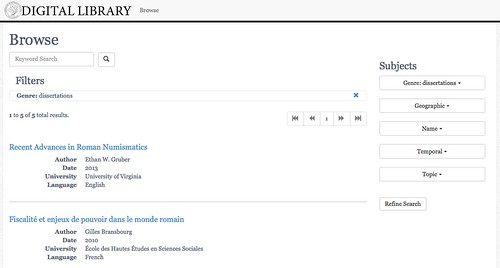
The American Numismatic Society (ANS) continues its mission of providing Open Access research tools to researchers worldwide with its newly unveiled Digital Library (http://numismatics.org/digitallibrary). The ANS Digital Library will grow to house three collections of digital material: numismatic theses/dissertations, auction catalogues, and ebooks.
Beginning now, the collection of electronic theses and dissertations hosts international doctoral work on numismatic themes. Anyone may browse the collection online, and are welcome to download any PDF or DOC file containing the research that earned their authors their MAs and/or PhDs. The ANS has seeded this space with the work of its own staff, and welcome any/all theses from numismatists, archaeologists, historians, and other scholars worldwide.
Andrew Reinhard, Director of Publications for the ANS, discussed the reasoning behind creating the collection. “Many numismatic doctoral theses and dissertations are never published, or they appear only in print that is accessible to very few people. The ANS is already an international destination for Open Access numismatic data, so it seemed logical that we also could be a hub for hosting advanced, groundbreaking numismatic scholarship.”
If you would like to have the ANS host and distribute your thesis or dissertation at no charge under a Creative Commons license, email the file(s) or link(s) to areinhard@numismatics.org. Once your work is uploaded, the ANS will publish its link, and will also create an entry in the DONUM library catalogue to aid discoverability. Over the next few months, the ANS will begin to share freely its scanned auction catalogues as well as ebook versions of its monographs and series on this Digital Library platform.
For more information, contact Andrew Reinhard, Director of Publications, at 212-571-4470 ext. 111 or areinhard@numismatics.org.
To access the Digital Library, see:
ANS Digital Library (http://numismatics.org/digitallibrary/)
To read the complete press release, see:
The American Numismatic Society Introduces Digital Library
(http://numismatics.org/NewsEvents/DigitalLibrary)

OCTOBER 2015 PAN SHOW LECTURE SERIES SPEAKERS
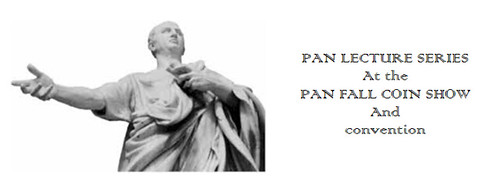
Please join us for an “Afternoon Oration”
The PAN Fall Coin Show Lecture Series will be held on Friday October 23rd in meeting room 5 at the Monroeville Convention Center, Monroeville, PA. The lectures are free and open to the public.
12:00 pm Dr. Darryl Gomez, - My Numismatic Research Discovery: Presidential Medal of Appreciation™ Award Medals
1:00 pm Ms. Gosia Fort, - "Invisible Ties: the Outliers from the Medical Medals Collection at Falk Library”
2:00 pm Mr. E. Tomlinson Fort - “John Stewart, Earl of Traquair, and the Edinburgh Mint”
3:00 pm Mr. Simcha Kuritzky, - “The History of Modern Zionism through Numismatics”
For more information on PAN and the upcoming show, see:
http://pancoins.org/
NOTES FROM E-SYLUM READERS: SEPTEMBER 20, 2015
Book Review: Who’s Who Among American Medallists
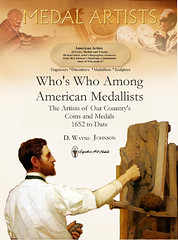 Regarding Dick Johnson's new book on American Medallists, Anne E. Bentley of the Massachusetts Historical Society writes:
Regarding Dick Johnson's new book on American Medallists, Anne E. Bentley of the Massachusetts Historical Society writes:
I ordered one for our library and am very glad I did! Dick has packed an amazing amount of information in this volume and his bibliography and index are enormously helpful. This was obviously a labor of love and I, for one, am very grateful for his hard work!
To read the earlier E-Sylum article, see:
NEW BOOK: WHO’S WHO AMONG AMERICAN MEDALLISTS
(www.coinbooks.org/esylum_v18n37a06.html)
The Most Used Individual Numismatic Book
Jeff Reichenberger writes:
This little tidbit was in our latest issue of NOW NEWS. (Vol. 53 No.3 Fall 2015.) (Numismatists of Wisconsin) Perhaps a candidate for 'Most Used Individual Numismatic Book'.
 David, a collector from Wisconsin, collects world coins. He plopped his tattered 1993 edition of Krause’s Standard Catalog of World
Coins down on my table and I just had to take a photograph of it. David carries the book to every coin show he attends. It serves not only as a
reference but also as his check list, every page has been penned or penciled with checks, underlines, or annotations. His goal is to find EVERY coin
in that book!! And, says David, “When the book wears out, I quit.”
David, a collector from Wisconsin, collects world coins. He plopped his tattered 1993 edition of Krause’s Standard Catalog of World
Coins down on my table and I just had to take a photograph of it. David carries the book to every coin show he attends. It serves not only as a
reference but also as his check list, every page has been penned or penciled with checks, underlines, or annotations. His goal is to find EVERY coin
in that book!! And, says David, “When the book wears out, I quit.”
For more information on the Numismatists of Wisconsin, see:
http://www.numismatistsofwisconsin.com/
A Mathematical Coin Puzzle
Gosia Fort writes:
I was browsing an old 1938 book "Mathematical Snapshots" when I stumbled on this problem illustrated with coins. I immediately thought of your young numismatists. Maybe math will not deter them from being interested in coin collecting but it seems to me a fun activity to test this problem.
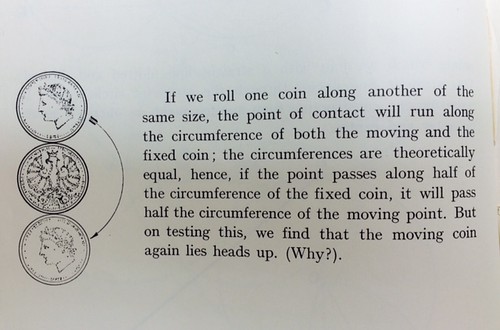
Morgan & Orr
Regarding the painting of the factory of Morgan & Orr, makers of coining equipment for the Philadelphia Mint, David Gladfelter writes:
They are listed in McElroy's Philadelphia city directories of 1852 and 1853 as machinists located at 461 Callowhill St. They made coin presses for the U.S. Mint. They issued a token (Wright 722) dated 1855 with an image of a coin press made for the Republic of Peru. Unfortunately I don't own this token.
Dick Johnson writes:
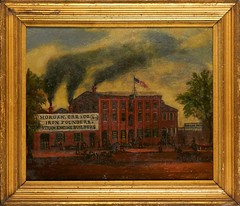 While researching artists of coins and medals in Philadelphia City directories I learned that Joseph Morgan and Arthur Orr were neighbors -
they lived next door to each other. You can imagine their walk home from their foundry shop (as I remember it wasn't far). But even if they rode
home in a carriage they undoubtedly talked to each other of the day's activities. Wouldn't it be interesting to overhear those
conversations?
While researching artists of coins and medals in Philadelphia City directories I learned that Joseph Morgan and Arthur Orr were neighbors -
they lived next door to each other. You can imagine their walk home from their foundry shop (as I remember it wasn't far). But even if they rode
home in a carriage they undoubtedly talked to each other of the day's activities. Wouldn't it be interesting to overhear those
conversations?
To read the earlier E-Sylum article, see:
NOTES FROM E-SYLUM READERS: SEPTEMBER 13, 2015 : Morgan Orr & Company
(www.coinbooks.org/esylum_v18n37a12.html)
On Classical Numismatic Group's 100th Catalog

Larry Gaye writes:
Congratulations on Classical Numismatic Group's 100th catalog and thanks for publishing the well written press release/history of this endeavor.
For many years my only source of information on Byzantine coinage came from CNG's catalogs. I just paged through my copy of number XIX, February 19, 1992 which featured an all Byzantine offering with many rarities that at that time I thought I would never own; I'm still looking for them though I have made a bit of progress. So many coins, so little time.
What a gift CNG - thanks, Victor, for pursuing the ancient world and bringing us these treasures.
To read the earlier E-Sylum article, see:
HISTORY OF CLASSICAL NUMISMATIC GROUP, INC.
(www.coinbooks.org/esylum_v18n37a10.html)
More on the Charlie Chaplin 'Gold Rush' Tokens of Early 1926
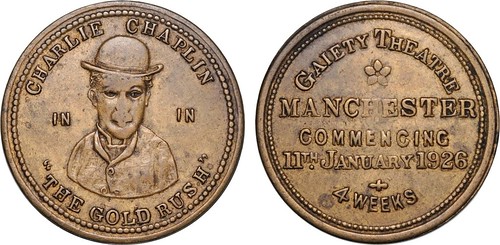
Brian Edge's article in the Token Corresponding Society Bulletin of September 2007 {Vol.8, no.12} concerns these tokens. There are pieces for ten known venues in Northern England, plus a manufacturer's advertising ticket.
On page 159 of his book "The First Dictionary of Paranumismatica", Brian describes how two men dressed as Charlie Chaplin were charged with creating a disturbance in Manchester, after scattering a number of these brass tokens on the pavements of the city for the purpose of advertising
To read the earlier E-Sylum article, see:
NUMISMATIC REMEMBRANCES OF CHARLIE CHAPLIN
(www.coinbooks.org/esylum_v18n37a17.html)
The Son of Douglas “Wrong-way” Corrigan
Last week's article on Larry Adams mentioned "A friend of Larry’s, Don Corrigan (the son of Douglas “Wrong-way” Corrigan)."
Tom Sheehan writes:
I thought the son's name was Doug. He did a lot of work with Neal Shafer and I on the Panic Scrip book.
To read the earlier E-Sylum article, see:
DR. LAWRENCE A. ADAMS (1935-2015)
(www.coinbooks.org/esylum_v18n37a09.html)
THE BOOK BAZARRE
ANSWERS: DENOMINATIONS NAMED AFTER PEOPLE
Jorge A. Proctor writes:
In the article "The Explorer, Conquistador, and the Currency" by "Aris Maragoudakis (Currency Specialist), she writes (about Panama's paper money): "The denomination itself is named after Balboa. To our knowledge, this is the only form of currency named after a specific person". This statement is not true. In fact, the currency of Nicaragua is named Cordoba, being named after a specific person (it is named after Francisco Hernandez de Cordoba, the founder of Nicaragua).
Alan Luedeking wrote as well:
Another obvious example is the Nicaraguan Córdoba, named after the Spanish Conquistador Francisco Hernández de Córdoba, who conquered the territory now known as Nicaragua in 1524 and founded the principal cities of León and Granada there. Ironically, he was a contemporary of Balboa's and suffered the same fate: running afoul of Pedrarias Dávila he was beheaded.
The Córdoba, as a denomination, was instituted in 1912 through a complex refinancing deal involving the New York banking firm Brown Brothers. Here's an image of Córdoba from the only crown ever issued by Nicaragua.
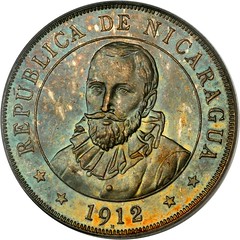
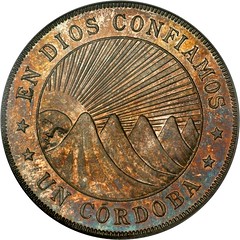
Ralf Böpple writes:
There are a lot of currencies named after real people in Latin America alone: The Venezuelan Bolivar (VEF), for whatever it may still be worth, named after Simon Bolívar.
Then there was the Ecuadorian Sucre (ECS), who got his name from yet another prominent leader of the independence movement in South America, until the country dollarized in the year 2000.
Maybe somewhat less prominent may be the Honduran Lempira (HNL), named after a local chief who fought the Spanish conquistadors.
Definitely the most prominent is Costa Rica's Colón (CRC), which is named after nobody less than Christopher Columbus. Also, El Salvador's currency was called Colón (SVC), but is being replaced by the USD.
Nicaragua's Córdoba Oro (golden Cordoba) or NIO is named after the founder of the country.
The Paraguayan Guaraní (PYG) is named after a whole people, so strictly speaking it does not make this list!
Fabrizio Raponi writes:
I think we can find other cases in coins in history. The “antoninianus”, a silver and later billon roman coin, was introduced by the roman Emperor Caesar Marcus Aurelius Severus Anotoninus Pius Augustus, nicknamed Caracalla. The “aurelianus”, a billon roman coin introduced by Caesar Lucius Domitius Aurelianus Augustus known as Aurelian. All the way to the Maria Theresa Thaler a silver Austro-Hungarian coin declared in 1857 to be an official trade coinage.
The remain in the world of banknotes, I think we have the Bolivar in Venezuela, after Simon Bolivar, the Colon in Costa Rica named after Christopher Columbus known as Cristobal Colon in Spanish.
We could mention the “Renminbi” which literally means "The People’s Currency”. So, in a broader perspective this denomination is named after everyone in China :) J Moving away from people we find currency named after animal like the Guatemalan Quetzal which is named after the national bird of Guatemala: the “resplendent quetzal”. It goes all the way back to the ancient Mayan culture when the quetzal bird’s tail feathers were used as currency.
Pete Smith writes:
How about the French gold coins, Louis d'or, named for Louis XIII? Also:
Francois d'or
Frederick d'or
Friedrich d'or
Leopold d'or
Maximillion d'or
Stanislas d'or
Wilhelm d'or
Iran has a denomination named for Muhammad Trier (German State) had a Petermenger named for St. Peter
Frank Crowe of Williamsburg, VA writes:
How about Costa Rica’s Colon, named after another explorer, Christobol Colon, AKA, Christopher Columbus.
Martin Purdy also suggested the Bolivar, Colon, Lempira, Córdoba, Sucre and Louis d'or. He writes:
How about the Louis d'or and the Napoleon? The Maria Theresia Thaler sort of fits, too.
Demoninations Named After People
- Balboa, Panama (Vasco Nunez de Balboa)
- Bolivar, Venezuela (Simon Bolivar)
- Colon, Costa Rica (Christobol Colon, AKA, Christopher Columbus)
- Cordoba, Nicaragua (Francisco Hernandez de Cordoba)
- Lempira, Honduras
- Muhammad, Iran
- Sucre, Ecuador
Coins Named After People
- Antoninianus, Ancient Rome (Emperor Caesar Marcus Aurelius Severus Anotoninus Pius Augustus [Caracalla])
- Aurelianus, Ancient Rome (Caesar Lucius Domitius Aurelianus Augustus [Aurelian] )
- Francois d'or
- Frederick d'or
- Friedrich d'or
- Leopold d'or
- Louis d'or
- Maximillion d'or
- Stanislas d'or
- Wilhelm d'or
- Petermenger (Trier [German State]) (Saint Peter)
To read the earlier E-Sylum article, see:
QUERY: DENOMINATIONS NAMED AFTER PEOPLE
(www.coinbooks.org/esylum_v18n37a27.html)
MACOMB MEDAL JUST ONE HIGHLIGHT OF SALE
Prices soared at this singular auction of the contents of Hauteville Manor. All 1600 lots on the auction block on Friday 11 and Saturday 12 September went for a total of CHF 4,379,600, or more than four times the low estimate for the sale. Nearly 100% of the lots found a buyer in a room that remained crowded over the two sale days with bidders of all nationalities (Swiss, French, American, Italian, British, Chinese, and more). “These results exceeded all our expectations. They show how attached buyers are to items with a prestigious and historic provenance,” affirmed Bernard Piguet, CEO and head auctioneer of the Hôtel des Ventes auction house. “This outcome mirrors the success of the exhibition days at the manor that drew 10,850 visitors in just three days!” Philip Grand d’Hauteville, spokesman for all the heirs to the manor, added, “The Hôtel des Ventes of Geneva organized this event with the utmost professionalism.
"The heirs were quite impressed with the cultural and administrative competence shown by the Hôtel des Ventes. The relationship that the family had with Bernard Piguet, supported by his team of specialists, was a model of perfection. We are happy to know that our family’s belongings have found new, enthusiastic owners, especially in Switzerland and the United States. We are particularly delighted that several pieces rejoined collections in Swiss museums and will therefore be complementing donations that we have already made.”
American Buyers Contest the Spoils of their History
The Americana section on Saturday night included major historical souvenirs from the War of 1812 and the American Civil War (1861-1865).
One hundred percent of the lots found an owner, for the sum of CHF 468,337 (estimate: CHF 80,000-100,000)!
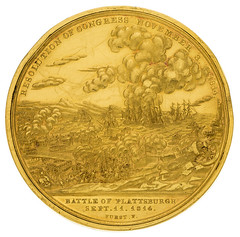 The air was electric as numerous bidders, mainly Swiss and American, battled by phone or in person for the medal of General Alexander
Macomb, an ancestor of the Grands of Hauteville and hero of the Battle of Plattsburgh of 11 September 1814. The room broke into applause as a bidder
in the manor’s orangerie, where the sale was held, made the winning bid. He acquired this unique item for CHF 231,000, which was more than 11 times
its low estimate (lot 1052, estimated at CHF 20,000-30,000).
The air was electric as numerous bidders, mainly Swiss and American, battled by phone or in person for the medal of General Alexander
Macomb, an ancestor of the Grands of Hauteville and hero of the Battle of Plattsburgh of 11 September 1814. The room broke into applause as a bidder
in the manor’s orangerie, where the sale was held, made the winning bid. He acquired this unique item for CHF 231,000, which was more than 11 times
its low estimate (lot 1052, estimated at CHF 20,000-30,000).
A new battle broke out a few minutes later for the Lone Star flag of the 5th infantry regiment of Texas, which included the Confederate Stars and Bars flag on the back. This one-of-a-kind item will soon return to American soil, as it was purchased by John Kraljevich, a specialist in historic American souvenirs from South Carolina, for the sum of CHF 56,000 (lot 1080, estimated at CHF 20,000-30,000).
The 10 military awards of General Macomb signed by Presidents Georges Washington, John Adams, Thomas Jefferson, James Madison, and John Quincy Adams also fetched high prices, selling for a total of CHF 46,700 (estimated at CHF 20,000-30,000).
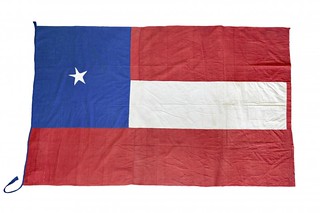
I didn't know John Kraljevich had an interest in flags. But I'm not surprised it's a damned historically important flag. He writes:
I like pretty much anything historical that I can add value to with some good, old-fashioned research, and this flag was the perfect case. Before the sale I found a reference to this precise flag in the letters of Robert Gould Shaw, the guy Matthew Broderick played in the movie Glory, relating that his friend Fred d'Hauteville, also of General Nathaniel Banks' staff, had received a "pretty Secessionist flag" from the famed spy Belle Boyd, the notorious "Siren of the Shenandoah." So this piece has an unbroken, documented provenance back to a teenaged vixen who was making the papers even in 1862 for daringly darting across battlefields, gathering intelligence from Union officers and reporting straight to the best known names of the Confederate officer corps.
The auction house has since amended their catalogue description after I told them the story so they could use it for their press outreach. I'm still not certain what I'll do with the flag, but it's one of the best Civil War flags extant. It is certainly the only one with a documented provenance to the Confederacy's most famous spy. It's been in the same hands since late June/early July 1862 and it remains exceptionally well preserved.
Needless to say, I would have loved to have bought the medal for a sensible price.
To read the complete article, see:
Hôtel des Ventes announces exceptional outcome at historic sale of contents of Hauteville Manor
(http://artdaily.com/news/81442/H-ocirc-tel-des-Ventes-announces-exceptional-outcome-at-historic-sale-of-contents-of-Hauteville-Manor-#.Vf2x1d-6dhE)
To read the earlier E-Sylum articles, see:
MACOMB BATTLE OF PLATTSBURGH GOLD MEDAL OFFERED
(www.coinbooks.org/esylum_v18n36a21.html)
NOTES FROM E-SYLUM READERS: SEPTEMBER 13, 2015 : Macomb Medal Brings $238,000
(www.coinbooks.org/esylum_v18n37a12.html)
COUNTERFEITING AND 1817/4 OVERDATE BUST HALVES
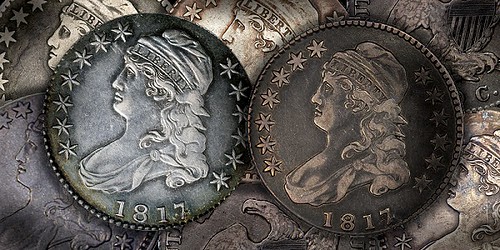
Before 2005, just seven 1817/4 overdate bust halves were known and four have curiously appeared since, bringing the total to eleven. The second or third finest is currently ‘in the news.’ The Meyer-Pogue 1817/4 will be auctioned by Stack’s-Bowers on Sept. 30, at Sotheby’s headquarters in New York city. as part of the Pogue II sale. Herein, a tentative condition ranking for this famous rarity is put forth.
The 1817/4 overdate bust half is the rarest Philadelphia Mint half dollar that is collected as a distinct ‘date.’ For a given denomination and design type, an overdate can be a second or third ‘date’ of the same year if the overdate feature is readily apparent without magnification. The 1817/3 half, the 1817/4 and the 1817 half with ‘normal numerals’ are considered to be three different dates by collectors assembling sets ‘by date.’
Around the same number of 1838 New Orleans Mint halves survive, between nine and twelve, possibly just nine. The 1838-O, however, is not a business strike and is of a different design type. The Eliasberg-Gardner 1838-O was auctioned in May 2015.
The Meyer-Pogue 1817/4
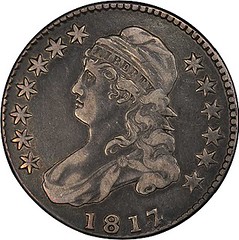 The Meyer-Pogue 1817/4 is mentioned ahead of the condition ranking as it is ‘in the news.’ It is PCGS graded Very Fine-35. The only one
graded higher by PCGS is the finest known Eliasberg coin, which is currently PCGS graded as AU-53. It was PCGS graded as AU-50 for many years.
The Meyer-Pogue 1817/4 is mentioned ahead of the condition ranking as it is ‘in the news.’ It is PCGS graded Very Fine-35. The only one
graded higher by PCGS is the finest known Eliasberg coin, which is currently PCGS graded as AU-53. It was PCGS graded as AU-50 for many years.
The Meyer-Pogue 1817/4 is a neat coin. The wear is honest and normal. The inner fields toned a brown-russet color and the russet outer fields are green tinted. The highpoints are of a tan hue and contrast well with the deeper toned fields. There are blue-green patches here and there, which naturally layered with the dominating brown-russet tone.
Miss Liberty’s hair is blurred and grainy as struck, which is typical for 1817/4 halves. The overdate feature is not as bold as it is on some others, though is clear.
Afterthoughts
Sheridan Downey strongly believes that the four new discoveries are all genuine. He adds that “it is very likely that more 1817/4 halves will be discovered in the future.” I am not convinced of either point.
The underlying four is rather apparent on 1817/4 halves and the premiums attached to this overdate have now been widely reported via the Internet. Are there many ‘1817’ halves that have not been re-evaluated?
From 1976 to 2004, there were no new discoveries of 1817/4 halves. On Nov. 29, 2004, the Eliasberg coin sold for $333,500. In the minds of people who make forgeries, this would probably be a rather hefty amount for an obviously circulated silver coin. The other half dollars that are worth more tend to grade above AU-55.
People who craft forgeries might have then logically figured that a deliberately worn and harmed, fake 1817/4 could be sold for at least $50,000. Even a net profit of $20,000 might be significant for some forgers. In earlier eras, fake rarities of this nature tended to be accidentally or deliberately mis-attributed die varieties or to be die-struck forgeries with clearly incorrect die characteristics, relating to the placement of numerals, stars, branches, or serifs on letters, among other design elements. With technology developed in the late 20th century, however, there is no longer a need to hand-engrave dies, punches or hubs.
An image on a computer screen can be impressed into a die without much human involvement. To a large extent, the die markers on a forgery made with such equipment may be the same as the die markers on a genuine piece. Of course, die-struck forgeries are different from genuine pieces in many ways.
In order to reduce the number and magnitude of detectable differences, the forgers may artificially wear or deliberately harm their products; there would thus be less ‘information’ available to be used for authentication. Heavily worn and/or non-gradable “coins” are harder to authenticate than high quality pieces.
I am curious as to the methods employed by the experts at PCGS and NGC to authenticate the four 1817/4 halves that appeared since 2004. Supposing, hypothetically, that a forger used a computer and die making equipment that was developed in the late 20th century. Most such equipment was probably geared towards producing the low-relief coins and tokens, with bland and simple design elements, that contemporary mints tended to manufacture during the last quarter of the 20th century.
One of the most difficult features for the forgers to reproduce might be the numerals of an overdate, as the effects of overpunching in the 19th century might not be effectively mimicked with automated die-engraving equipment. Therefore, hypothetically, if the numerals of the overdates seem fake on a fake, the forger may scrape the area around the numerals and elsewhere on the obverse to deflect attention from not so deceptive aspects of his creation.
In any event, it might very well be true that all four new discoveries are certainly genuine, and I am not suggesting otherwise. I raise these issues because I suggest that collectors who spend large sums on such coins are logically and ethically (though not legally) entitled to an explanation regarding methods of authentication.
Besides, even if these four are all genuine and they might very well be, it is certain that there are people in Asia and in Eastern Europe who are producing forgeries of rare coins. There needs to be additional open discussion of methods employed to make fakes and of methods employed to authenticate coins.
To read the complete article, see:
The Rarest
Half Dollar Coin of the Philadelphia Mint: The 1817/4 Overdate Bust Half
(www.coinweek.com/us-coins/the-rarest-half-dollar-coin-of-the-philadelphia-mint-the-18174-overdate-bust-half/)
THE BOOK BAZARRE
QUERY: ARTIST NICHOLAS GEVELOT INFORMATION SOUGHT
Geoffrey Bell writes:
I am presently doing some research on Nicholas Gevelot. He was a sculpture artist in Philadelphia in the 1820-1860 period. He produced a medal on Zachary Taylor in 1850. I am looking for the following:
1. Does anyone know where I might find an image of Gevelot?
2. Is there an image of the medal or the medal itself located somewhere?
3. How does one access the New Haven obits of 1873?
Any help our readers can furnish would be appreciated.
ISAAC FRANCIS WOOD (1841-1895)
Isaac Francis Wood (1841-1895), born on Thursday, July 15, 1841, in the old 7th Ward of New York City, then called the Quaker Ward, the son of Dr. Isaac Wood, M.D. (1793-1868), and his third wife Margaret Morell Hicks (1798-1873), the widow of Harvey Street. He was christened Francis Augustus Napoleon Wood. Later in life he changed his name twice: first, to Francis Augustus Wood, and second, in 1868, upon the death of his father and in his honor, as Isaac Francis Wood.
His father was the founder of the New York Institution for the Blind, and his third wife Margaret Morrell Hicks Wood. He is a direct descendent of Joseph Wood of Gloucestershire, England. His paternal grandfather was Samuel Wood of Oyster Bay, Long Island, New York. His maternal grandfather was John Hicks of Hempstead, Long Island, New York. In their day the Hicks, Wooley, Seerings and Wood families were the most prominent on Long Island.
He entered Haverford College at age 15 years in 1856. He was the founder of the Haverford Alumni Prize Medal for Oratory and Composition. He was the Vice-president of the Loganian Society. He was one of the founders of the Everett Society, and Vice-president of the Alumni Association (1877) and president (1878). He graduated B. A. 1862.
He worked for William Wood & Company the leading publisher in the city and was made a partner in the firm in 1868. He retired in 1871.
Numismatic Career :
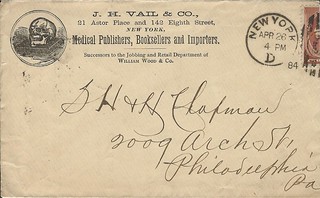 In order to give him perspective in American numismatic history Samuel Hudson Chapman was born on Wood's 16th birthday. Wood is an
illustrious figure born immediately after the very end of Post-Revolutionary War America 1800-1840, and the very beginning of Antebellum America.
Coin auction sales had become common for two decades prior to his birth. Collecting coins and studying numismatics were subjects that certainly were
salient at Haverford College and most probably when he began interest in coins and medals.
In order to give him perspective in American numismatic history Samuel Hudson Chapman was born on Wood's 16th birthday. Wood is an
illustrious figure born immediately after the very end of Post-Revolutionary War America 1800-1840, and the very beginning of Antebellum America.
Coin auction sales had become common for two decades prior to his birth. Collecting coins and studying numismatics were subjects that certainly were
salient at Haverford College and most probably when he began interest in coins and medals.
His interest in finding fellow associates to collect with led him to be one of the revivers of the American Numismatic and Archaeological Society (ANS) in 1864. He joined the American Numismatic and Archaeological Society on February 5, 1864 at the age of 22, and later became a Life Member.
In April 1864 he wrote to Henry Champion of the New Haven Numismatic Society regarding the catalogue of the Yale College Collection. Champion replied he never heard of the ANS, which led him to look into the matter of its incorporation. He spearheaded the nine incorporators of the American Numismatic and Archaeological Society on May 16, 1865. About this time he also spread the circular of the ANS for the Abraham Lincoln Medal soliciting through the mail its sale at $5 each and 20 % discount to any agent obtaining subscriptions. He was one of five members appointed to a committee in March 1866 to found a journal for the society, which became the American Journal of Numismatics. He served as the ANS Librarian from 1869 to 1879.
In 1869, he commissioned William H. Key to produce “St. Paul’s Church, Norwalk, CT” and George H. Lovett to produce a “Memorial Series” of medals beginning with “Andrew Jackson’s Public Entry into N. Y., 1866”, and in the late 1870’s restrikes of the Augustus B. Sage, Historical Tokens Series, from the original dies left in the ANS donated in 1867. In 1874, the 4th medal was struck in the “Memorial Series” depicting the Boston Numismatic Society on the obverse and the New England Historical and Genealogical Society on the reverse.
In 1875, he was responsible for renting a room and space for a bookcase at Mott Memorial Free Medical Library, 64 Madison Avenue, thereby providing the ANS with its first permanent space, though rented for one year. That same year he subscribed to Sylvester Sage Crosby’s Early Coins of America.
From 1877 to 1877 he advertised buying Grant medals. In 1876 he issued a satirical political candidate medal of Samuel J. Tilden, calling him instead of Sammy, Shammy.
During his final years of tenure as Librarian, James Pollack, director of the U. Mint ceased selling coins to societies at wholesale. Consequently, he was appointed by the ANS to be their member of a joint committee formed by the Boston Numismatic Society and the Numismatic and Antiquarian Society of Philadelphia to have the U. S. Mint continue selling coins at wholesale to numismatic societies. This renewal occurred under the directorship of Col. A. Louden Snowden on March 1, 1879, nearing the end of Wood’s librarianship.
About this time he operated the New York Medal Club, also located at the Mott Memorial Free Medical Library, 64 Madison Avenue, advertising in the American Journal of Numismatics April, 1879, as an issuer and dealer of medals.
To read the complete article, see:
WOOD, ISAAC
FRANCIS (https://sites.google.com/site/numismaticmallcom/encyclopedic-dictionary-of-numismatic-biographies/wood-isaac-francis)
THIAN MASTER CONFEDERATE CURRENCY ALBUM OFFERED
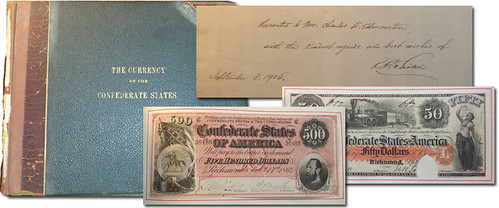
A newly discovered 109-year-old Confederate Currency album could bring more than $60,000 in the Stack’s Bowers Galleries Official Currency Auction of the Whitman Coin & Collectibles Winter Expo this November in Baltimore, Maryland.
The album, titled “The Currency of the Confederate States,” was assembled by early Confederate Currency researcher and author Rafael Prosper Thian. Thian worked for decades in the Adjutant General’s Office of the United States Army from the middle years of the Civil War until his death in 1911. During that time he had nearly unrestricted access to the “Rebel Archives” confiscated from Richmond in 1865. He used that access to do some of the earliest research into Confederate Currency and to publish a number of publications detailing the history of the Confederate Treasury Department. Among those publications is the oft-cited “Register of the Confederate Debt.”
Also during that time Thian produced several albums demonstrating the different types of currency produced by the Confederacy. Some of those albums displayed just a single note for each type. Others, known now as Master Albums, displayed various plate varieties and watermarks that Thian identified during his research. It is believed that fewer than ten of these Master Albums were ever produced and today only around six are known with at least half of those in permanent government or institutional collections.
The album contains over 425 pages including a preface with a description of contents and a history of the various acts for each issue. One of the inner leafs is inscribed in Thian’s hand “Presented to Mr. Charles D. Edmonton, with the kindest regards and best wishes of R. P. Thian September 8, 1906.”
Enclosed within the album are 287 examples of Confederate currency. Six of those examples are period sepia photographs of types 1 through 6. There are 275 actual Confederate Treasury notes and six examples of the Chemicographic back impressions originally intended for the 1864 issues. Pages are letter-pressed with a note number assigned by him to each variety rather than individual type along with plate or variety info for that note. One of the notes found in the album is a new to the census T-35 1861 $5 “Indian Princess” note.
Each note is mounted one per page using a period adhesive in each corner tip. It is our understanding that this adhesive can be neutralized to remove the notes if so desired. However it is the wish of both the consignor and the firm that this historical relic and its contents be preserved for future generations in its intended form.
The album is completely new to the market and represents a miracle of survival. A family member of the consignor received the album as a reward for finding a neighbor’s ring in the early 1950s. Since that time it had resided, forgotten, in a basement in the Carolinas. Earlier this year the album was noticed by the consignor and picked from a trash pile as the family was cleaning out the basement and thus was saved from being lost.
The pages and the notes within are preserved in basically the same condition as they were when the album was assembled. The front cover and a few inner leaf pages have detached along with the spine of the book. All but the spine are present and could be reattached by an expert book restorer.
To read the complete article, see:
(www.stacksbowers.com/NewsMedia/Blogs/TabId/780/ArtMID/2678/
ArticleID/65363/Newly-Discovered-Thian-Master-Album-of-Confederate
-Currency-Could-Bring-60K-in-Upcoming-Stack%E2%80%99s-Bowers-Auction.aspx)

DESIGNING THE PEACE DOLLAR
The Peace dollar is often overshadowed by the Morgan dollar. The roughly 187 million Peace dollars struck between 1921 and 1935 was a fraction of the half billion Morgan dollars struck in their time, between 1878 and 1904 and again in 1921. Collectors are often content to have a single example of the high relief 1921 Peace dollar and the modified, lower relief 1922 to 1935 issues for type purposes in their collections, favoring to collect instead the romantic Morgan dollar that brings to mind the Old West.
The story of the coin, from the frantic production of the new high relief design in the last week of 1921, the controversy over the design reverse’s symbolism and the romantic notion that designer Anthony de Francisci based Liberty’s head off of the features of his new bride make the series irresistible.
It might surprise many to learn that the first Peace dollars weren’t struck until late December 1921. In 1920, U.S. Mint engraver George T. Morgan was called upon to revisit his Morgan dollar design and to produce dies for the production of new silver dollars as millions of new dollars were needed to replace silver dollars that were melted under the Pittman Silver Purchase Act of 1918. In short, the act required the U.S. government to sell silver to the United Kingdom, and this was met by melting more than 270 million silver dollars.
In his 2012 A Guide Book of Peace Dollars, Roger Burdette called the Peace dollar “something of a mystery coin since it was first released to the public on December 20, 1921.” He wrote, “Initial press releases told conflicting tales of its design and promoted the sculptor’s use of his attractive wife as a model. Only the most superficial information was publicly released on how the coin came into existence.”

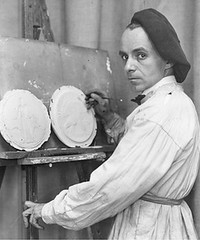
de Francisci with his wife; de Francisci working on the dollar reverse
Anthony de Francisci was, along with most sculptors in the United States, consumed with producing wartime memorials, sculptures and medals commemorating World War I in the years immediately after the Great War ended.
For the Peace dollar design, de Francisci drew upon work for items he had recently completed, including the Verdun city medal and the Peace of Versailles medal design. Trial sketches for the reverse show the artist experimenting with a flying eagle not dissimilar to that used on Augustus Saint-Gaudens’ double eagle and an eagle breaking a sword that looks to Weinman’s Walking Liberty half dollar, with nods to the eagle seen on Bela Lyon Pratt’s sunken Indian Head gold $5 half eagle and $2.50 quarter eagle.
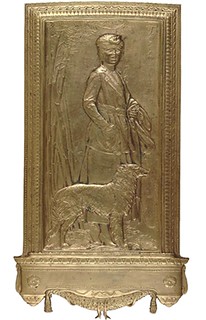
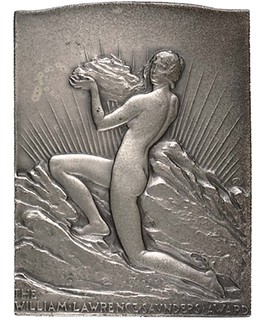
1920 relief of artist's wife; 1927 Mining Award medal
Images courtesy Smithsonian American Art Museum
De Francisci’s Peace dollar design shows parallels to his other work. The use of visible sun rays is a motif that he used in many designs, including those he prepared for the 1938 Jefferson 5-cent competition that he lost to Felix Schlag.
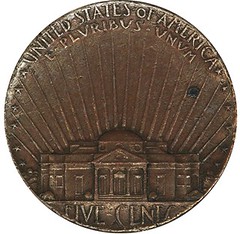

1938 Jefferson Nickel Designs
Photo Credits: Heritage; Smithsonian American Art Museum
To read the article on the Coin World site, see:
Collecting the Peace dollar
(www.coinworld.com/news/us-coins/2015/09/the-intriguing-history-the-peace-dollar.html)
BURNS MEMORIAL REFERENCE LIBRARY DEDICATION
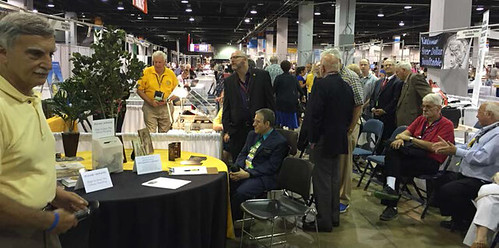
The John Burns Memorial Reference Library dedication ceremony at the American Numismatic Association World’s Fair of money was a very well received event. A crowd of 30-40 notable numismatists, friends, and media were on hand for the this emotional and memorable ceremony. John’s estate administrator, Pat McBride, organized the dedication. The emcee was Sam Deep one of John’s good friends. Sam and NBS E-Sylum editor Wayne Homren recalled stories of John’s life.
Kerry Wetterstrom of CNG Inc. suggested to McBride that John would not be very pleased with this whole traveling library idea with his namesake. Kerry remembered that John would frequently complain to him about the customers that would browse through his book inventory and would walk away without purchasing anything. He would mumble with the forceful resonance that was one of his noted trademarks, “This ain’t no library. This stuff is for sale!”
There were some very nice book donations made by Denis Loring, Allan Schein, Jeff Starck, Paul Cunningham, Carl Waltz, and many others that came by during the show. A donation box was set up for contributions to help keep the wheels on the traveling library. There were cash donations alon with pledges made by John Kraljevich, Ira Goldberg, and Bill Shamhart.
The outpouring of support was bolstered by quite a number of noted numismatists that came back to the Club Midway section to be a part of the occasion. ANA president Walter Ostromecki, Executive director Kim Kiick, and Convention Director Rhonda Scurek represented the American Numismatic Association.
Other notable attendees included Cliff Mishler, George Kolbe, David Fanning, Kathy McFadden, David Crenshaw, Ken Bressett, Charles Morgan, Dave Harper, David Lisot, Simcha Kuritzky, Dr Larry Korchnak, Ted Shiff, Tom Uram, Rich Jewell, Tom Corey, and Library Curator Ed Krivoniak. Some of the most heart warming attendees were the regular collectors that came by to recount a story about John or a chat that he may have had with them at a show. It turned out to be many more friends than expected. There were inquiries about bringing the library to the FUN Show in January and the Central States Show in April. We’ll see how the funding goes. Check the Library page on the PAN website: http://pancoins.org/john-burns-memorial-reference-library/
THE DYING ART OF THE OBITUARY
 But even though my days as an obituary writer were not that long ago, the culture of obituaries has changed greatly in the last few years.
For one thing, newspaper numbers are dwindling: from 1990 to 2006, Pew Research Center calculated a 14 percent drop in daily papers in circulation.
Social media has transformed how we communicate, as well, creating constantly pruned self-told stories. The obituary as we know it might be over. How
will we remember the dead in the future? And what did we do in the past?
But even though my days as an obituary writer were not that long ago, the culture of obituaries has changed greatly in the last few years.
For one thing, newspaper numbers are dwindling: from 1990 to 2006, Pew Research Center calculated a 14 percent drop in daily papers in circulation.
Social media has transformed how we communicate, as well, creating constantly pruned self-told stories. The obituary as we know it might be over. How
will we remember the dead in the future? And what did we do in the past?
In 1990 there were 1,611 daily papers in circulation. By 2009 there were 1,387, a decrease that only continues, according to the Pew Research Center’s 2014 State of the Media. Fewer papers equal fewer obituaries, which mean a shift in who is awarded space for a reported life story. (Mainly famous people, really.)
I asked Holly Shreve Gilbert, a journalism instructor at Oakland University and interim president of the Funeral Consumers Information Society (yes, a real thing), about the shrinking number of newspapers, and its effect on obituary coverage. First she laughed off her own obituary obsession: “I really am a happy person,” she said. (I could relate.) And then: “Hyper-local journalism is dying, and so is the obituary of the local person.”
This shift in death coverage, however, is more importantly due to the rise of the digital age. With Facebook, Twitter, Snapchat, and Instagram, we are not only able to consume more media, but are able to create more media, media that narrates our lives the way we want it to be narrated—in effect, we have more control over our own life story now than ever.
And this translates to our death story. Today, instead of objective, reported obituaries or even paid, family-written eulogies printed in newspapers, there are sites like legacy.com—which publishes family- or even self-written obituaries online, complete with a guest book for comments—and myebit.com, which allows you to “create a free custom memorial at the world’s largest memorial site.” In February of this year, Facebook changed its policies, allowing you to designate a friend or family member to execute your Facebook “estate,” managing your account after you’ve died.
“Obits have changed a lot over the history of the U.S. and now they’re undergoing another sea change with the rise of digital technologies,” said Janice Hume, journalism professor at Grady College and author of the book Obituaries in American Culture. “For those of us who were traditional newspaper people, the idea of some of the content that comes into these digital obits, particularly message boards or guest books, it’s content that we would never have dreamed of putting in. In guest books, people talk to the dead: ‘Go tell my aunt Marjorie I say hello.’”
“It's all very soft and loving,” said Dr. Nigel Starck, author of Life After Death: The Art of the Obituary. “But it's untrustworthy and full of lies. It's just untrue. It's rubbish. But people want to express their grief. You cannot trust them as a historical source.”
“When I think of an obituary, it’s as objective as journalism can be, a story on someone’s life,” Gilbert told me. “Now, if it’s on legacy.com or Facebook or a blog, we’re basically whitewashing everyone’s lives. We’re all happy. Everyone is happy.”
To read the complete article, see:
THE PERPETUALLY DYING ART OF THE
SMALL-TOWN OBITUARY (www.atlasobscura.com/articles/the-perpetually-dying-art-of-the-smalltown-obituary)

SWEDEN'S BLODSKLIPPINGAR OR 'BLOOD KLIPPE'
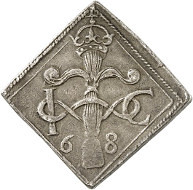
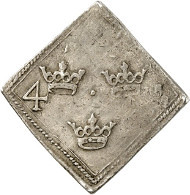
Blodsklippingar or blood klippe is the Swedish numismatic term for coins that tell the story of one of the darkest periods of Swedish history: the drama of fraternal feud and a revolt, of great love and courageous women, of insanity, passion and lust for power – simply put, topics, numismatics is normally about.
For starters, let us take a look at how the distrust between the Swedish King Erik XIV and Nils Sture came about. The Sture family was one of the most influential families in Sweden. Numerous members of the family had been appointed imperial governor, the very same position in which Nils Sture served the King. During his appointment Nils visited many courts throughout Europe to represent Sweden’s interests. But suddenly, the King tortured this cosmopolitan diplomat and sentenced him to death – because his astrologer predicted, that a man with blond hair would succeed him.
Eventually, though, Erik came to realize, that through his horrific actions he had alienated the aristocracy. He pardoned Nils, but not without making him suffer more. Seated on a wretched hack, Nils had to ride through the streets of Stockholm wearing a straw wreath on his head and thereafter, he was required to leave Sweden. Nils’ supporters and friends gathered at the near-by Sture Castle to demonstrate solidarity. Now, of course the attendees probably didn’t have many nice things to say about the King, but was it really at this farewell party, that a revolt was planned?
The King thought so and had one of the pages tortured. As expected, the boy confessed to everything. Thereupon, all the guests, which were present at the party, received a royal invitation to Svartsjö Castle. The ones who actually showed up were arrested and convicted for participating in a conspiracy and after sentencing were brought to Uppsala for incarceration.
By this time, King Erik suffered from serious mental illness. He visited the dungeons in Uppsala twice to first beg Nils Svante Sture, for his forgiveness and then a second time to stab him. It is said, that after the murder, the King ordered the guards to kill everyone else connected to the alleged conspiracy – except for ‘Mr Sten.’ There were two men in the dungeons who bore this first name and they were the only ones to survive.
A few days later, King Erik was found wandering the woods, apparently confused and disoriented. He was brought back to Stockholm and his mistress Karin Mansdotter was the only person who dared to approach him. Only one person, Katharina Stenbock, who was virtually related to every victim, demanded an audience with the King concerning the killings in Uppsala and her request was granted. Upon her arrival Erik threw himself to her feet, begged for her forgiveness and ordered his lawyer to strike an agreement. Not only did the widows and orphans of the victims receive a royal confirmation of what had happened and that their loved ones were innocent, but they also received a generous financial compensation.
Märta Leijonhufvud, the widow of Svantje Sture, donated her share of the blood money. It would fund the noblemen’s revolt against King Erik that soon did break out, which means that Erik’s atonement payment actually supported his own downfall.
The revolt was led by Erik’s two brothers, John and Charles. To save time, the rebels did not strike the usual round-shaped coins. Instead they produced roughly cut quadrangular plates. These klippe coins were also issued in different denominations, such as ½, 1, 2, 4, and 8 marks. The common term for this money, because of its purpose, soon became blood klippe or blodsklippingar.
Mickel Hansson, who worked at the Vadstena mint that accompanied the army, designed the coins. The obverse depicts a crowned sheaf, which presents the heraldic symbol of the royal house of Vasa. It is entwined by a ribbon, which likewise weaves around the rebel’s initials - I for John and C for Charles. The reverse shows the Swedish coat of arms with the three crowns.
As part of a special Sweden collection, one of these blood klippe will be offered for sale at the upcoming Künker Auction 266 on September 28, 2015. The specimen is estimated at 1,500 euros, once again proving that it is not always the coin with the highest estimate that tells the most thrilling story.
To read the complete article, see:
Blood money
(http://coinsweekly.com/en/Blood-money/8?&id=539&type=a)
EXHIBIT: THE SUN KING AND THE PRINCES OF MONACO
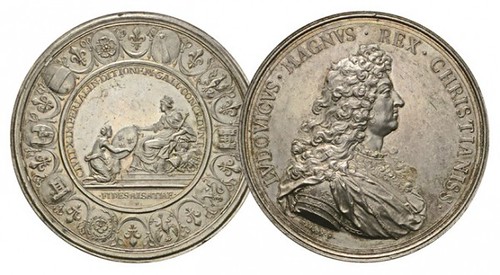
The Museum of Stamps and Coins (Musée des Timbres et des Monnaies) in Monte Carlo has announced that they will host a November exhibition featuring coins and medals issued during the reign of Louis XIV (1643-1715) of France, a rich and eventful time for Monegasque history. “The Sun King and Princes of Monaco Exhibition” will also include various medals and coinage that circulated in the small principality of Monaco.
2015 marks the 300th anniversary of the death of King Louis, referred to as the “Sun King.” He is also remembered in Europe for his reign of 72 years and 110 days, the longest of any monarch of a major country in European history.
The history and intrigues involving France and Monaco have spanned centuries, especially between sovereigns of the two entities. The French King was Godfather of the future Prince Louis I of Monaco, who was prince at a time when their two countries enjoyed a privileged alliance, following the Treaty of Péronne in 1641.
Marriages of future princes of Monaco with French senior princesses served to increase their titles and decorations. The presence of the Monegasque princes at the Court of France, together with their ability to move freely within the kingdom, increased their influence and responsibility to the French Crown; this included heading the French Embassy in Rome, which was entrusted to the Prince of Monaco.
Louis XIV, the Sun King of France, did more than create Versailles and elevate the arts and letters to their highest level in Europe. For Monaco, Louis XIV remains the French head of state who fostered the principality by according it a privileged alliance between the two states in 1641 by enacting the treaty of Peronne. Under the reign of Louis XIV, and with his constant support, the reigns of Princes Honoré II, Louis I, and Antoine I encouraged tremendous growth to Monaco and the entire southern region of France.
A sincere and loyal friend of the principality, Louis XIV showered the princes and the principality with his attentions and favors. He organized high-ranking weddings, conferred prestigious titles and high military ranks, made the Prince of Monaco ambassadors to the Pope, and won the respect of his contemporaries by enacting the French/Monegasque Treaty of Péronne. Above all, Louis XIV conceived with Antoine I an estate solution that would allow for a matrimonial alliance in 1715 between the Grimaldis and Matignons, thus ensuring the sustainability of the dynasty together with all their possessions.
The exhibition will place several rare and historical items on display, with 72 years of history recounted in a set of unique documents preserved in the archives of the Prince’s palace. Also included will be exceptional coins and medals belonging to the National Library of France, the Museum of Art History of Vienna (Austria), the Cabinets of Medals of Marseille and Lyon, and private collectors, highlighting a great near-century that was as important to Monaco as it was to France. Many of these rare coins and archival documents are infrequently seen or exhibited.
The exhibition will display for the first time several sets of rare coins of Dauphiné, Béarn, and Flanders, illustrating the history of Franco-Monegasque relations at the time. The display traces the strong ties that united Princes Honoré II, Louis I, and Antoine I to Louis XIV for the duration of his reign.
The exhibition will be held in conjunction with the Monte Carlo Auction and Numismatic show organized by Editions Gadoury, from the 14th to the 15th of November, 2015. The Musée des Timbres et des Monnaies is located at Terrasses de Fontvieille, Monte Carlo. The bourse opens on the November 15. For additional information about the exhibition and the popular coin show, please visit the Web site of Editions Gadoury.
For more information, see:
http://www.gadoury.com/en/auction
To read the complete article, see:
“The Sun
King and the Princes of Monaco”: An Exceptional Exhibition at the Museum of Stamps and Coins
(http://news.coinupdate.com/the-sun-king-and-the-princes-of-monaco-an-exceptional-exhibition-at-the-museum-of-stamps-and-coins/)

AN 1839 VICTORIA PROOF SET
On September 9 this year, the UK's current Queen, Elizabeth II, became the longest reigning Monarch these shores have ever known, surpassing the record previously held by her great-great-grandmother, Victoria.
63 years is rather a long time to sit atop a throne, and there have inevitably been a few world events and changes since a young Princess Elizabeth ascended the steps at Westminster Abbey to claim her new title. As far as the numismatist is concerned, however, arguably the most important event to happen during her reign was the advent of decimalisation.
The move, in 1971, was controversial at the time (people are resistant to 'change'), and had the effect of moving a long-standing series of coins (hands-up who remembers paying for things with a florin?) from the pockets of nylon and crimplene flared trousers and into the realms of the collectors.
Many of the coins from pre-1971 are, of course, still available in significant numbers. There are, for example, plenty of old farthings hiding in attics and at the bottom of grandmother's purses. Anyone with a metal detector and a half-decent reference book has found a sixpence or two upon the moor. And the reason for these coins' profligacy is pretty clear - there were a lot of them, produced and circulated in abundance, used on a daily basis.

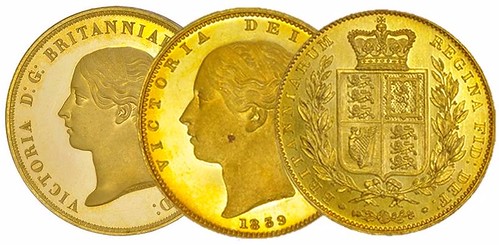
The rarity of these coins, then, is understandable. And, as with the majority of coins of this nature, the older the coin the more the condition varies. When a complete set appears, then, especially one that is in virtually mint condition, the occasion calls for some fanfare.
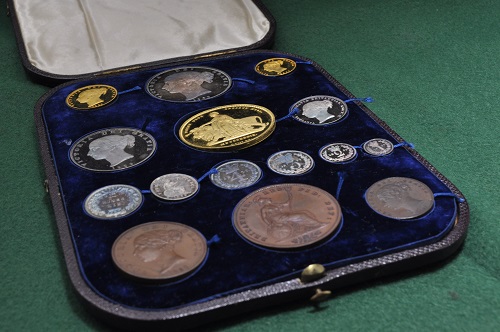
The Victoria Proof Set from 1839 that appears in our auction on 24 September at our London Offices is one such set. Without a doubt the finest of its type ever to have passed through our saleroom, it has been graded the highest ever by the NGC (Numismatic Guarantee Corporation), and also carries a remarkable provenance, with an attached label demarking the last time it was sold at auction - on April 10 1856 at Sotheby's, where it sold for a magnificent £10 and 10 shillings - around £465 in today's money.
Today, we reckon its worth a bit more.
Proof sets are not uncommon, especially sets post-decimalisation. Gone may be the days when a first class degree in mathematics was required in order to work out your change, but so, arguably, has a little of the romanticism that comes with a pocket full of florins and sixpences.
Whether the coinage of today (not just in the UK, but the euro, the dime and the dollar fall into this category as well) will have the same level of collectability in the future is a matter of some debate. Queen Elizabeth II's reign has seen so much significant change in the world that it is not unreasonable to predict that we may well see such coinage consigned to the collecting cabinets in the future (Apple Pay, anyone?).
Until that happens, we will continue to marvel at, and to covet, that which has come before.
To visit the Baldwin's web site, see:
http://www.baldwin.co.uk/
NUMISMATIC TOUR OF CUBA PLANNED
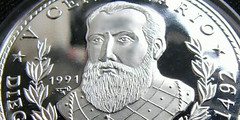 You are invited to travel to Havana, Cuba for a unique numismatic experience. For the first time ever, Dana Reed from ASC INTERNATIONAL USA
in Tampa Fl has put together a 5 day numismatic adventure to explore the history of Cuban coins, currency and recovered treasures from the Spanish
Colonial era.
You are invited to travel to Havana, Cuba for a unique numismatic experience. For the first time ever, Dana Reed from ASC INTERNATIONAL USA
in Tampa Fl has put together a 5 day numismatic adventure to explore the history of Cuban coins, currency and recovered treasures from the Spanish
Colonial era.
The trip includes visits to the Cuban National Mint and National Bank, a private visit to the Cuba Numismatic Museum to tour historic recovered treasures, and discussions with Cuban experts on the future of the Cuban monetary system and peso conversion.
The Trip Package, scheduled from November 24 – 28th and departing from Tampa Fl., includes the following:
- Air plane ticket
- Cuban Visa
- OFAC License
- Five Days Four Night stay @ Melia Cohiba hotel
- All breakfasts, three lunches and two dinners
- All ground transportation
- English speaking tour guide
- Complete access to all Museums included in the program
- Meetings with International Banking, Economic and Numismatic specialists
- Tour of Old Havana
- Tour to Varadero.
PRICE PER PERSON IN DOUBLE ROOM $ 2,500.00 Full program (Add $ 300.00 to each package for single room occupancy).
Special – Groups of 3 or more are only $2250
DAY 2 – WEDNESDAY
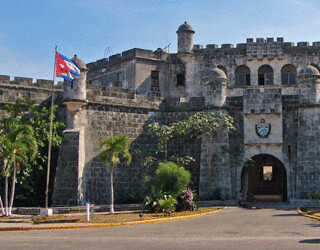 Full breakfast at Hotel. Meeting with Cuban National Bank authorities. Private visit of the Cuba Numismatic Museum (Castillo de la Real
Fuerza) which is the castle fort in port of Havana and now the home to the Cuban treasure museum. We will get a private behind the scenes tour with
the curator of the museum. The renowned Cuban historian, Alberto Prieto, will give a lecture on the history of the role Cuba played during the
colonial period as the central location of Spain’s new world colonial empire and the administrative role Cuba played as the logistics center of the
wealth of gold and silver plundered from Central and South America and it’s transshipment back to Spain. The museum has three exhibition halls and a
collection that includes more than one hundred sixty thousand pieces representing all continents. Lunch at El Templete Restaurant. Guided walking
tour of Old Havana, a UNESCO World Heritage Site. Dinner at La Moneda Cubana Restaurant.
Full breakfast at Hotel. Meeting with Cuban National Bank authorities. Private visit of the Cuba Numismatic Museum (Castillo de la Real
Fuerza) which is the castle fort in port of Havana and now the home to the Cuban treasure museum. We will get a private behind the scenes tour with
the curator of the museum. The renowned Cuban historian, Alberto Prieto, will give a lecture on the history of the role Cuba played during the
colonial period as the central location of Spain’s new world colonial empire and the administrative role Cuba played as the logistics center of the
wealth of gold and silver plundered from Central and South America and it’s transshipment back to Spain. The museum has three exhibition halls and a
collection that includes more than one hundred sixty thousand pieces representing all continents. Lunch at El Templete Restaurant. Guided walking
tour of Old Havana, a UNESCO World Heritage Site. Dinner at La Moneda Cubana Restaurant.
DAY 3 – THURSDAY
Full breakfast at Hotel. Meeting with Cuban economy experts. Discussion on Cuban peso conversion and future of the Cuban monetary system.
Visit to the Cuban National Mint. Visit Art Fuster’s Project and Gallery. Lunch at la Fontana Paladar. Visit to San Jose flea market one of
the famous handicraft market of Old Havana where you can purchase all sorts of crafts and souvenirs by local artisans. Dinner at La
Moraleja Paladar.
To read the complete article, see:
Travel to
Havana for a Unique Numismatic Experience Exploring the History of Cuban Coins
(www.coinweek.com/world-mints/travel-to-havana-for-a-unique-numismatic-experience-exploring-the-history-of-cuban-coins/)
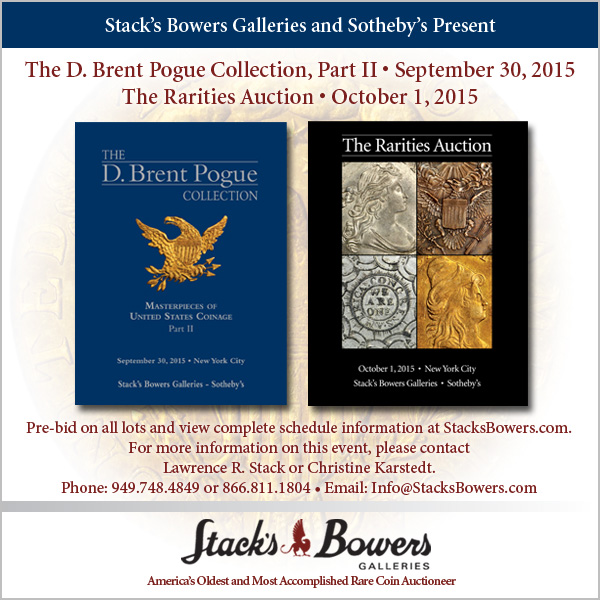
ARTIST INCORPORATED SIGNATURE INTO SCOTTISH BANKNOTE
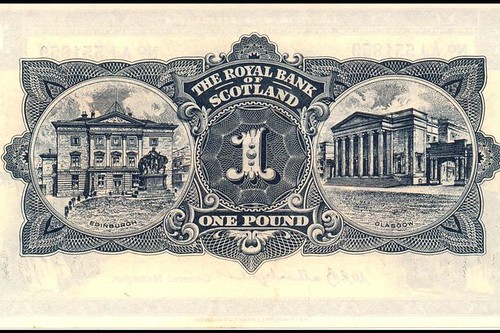
A CHEEKY Scots printer had his name signed on more than 50 million bank notes after carving it onto the master printing plate.
Apprentice WH Egan subtly forged his name on the vignette used to make £1 notes for the Royal Bank of Scotland.
He worked for Edinburgh printers W&AK Johnston, who produced paper notes for RBS.
Between 1956 and 1967, the firm issued in excess of 50 million of the notes - which had Egan’s signature hidden in cobblestones in front of an image of the Bank of Glasgow building.
He was given the job of re-drawing the worn-out metal printing plate for the £1 note that was first issued in 1927.
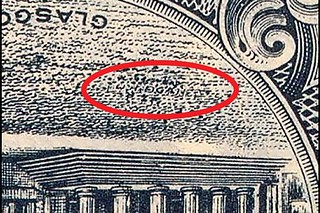 His name is only visible by turning the note upside down, and peering closely at it using a magnifying glass.
His name is only visible by turning the note upside down, and peering closely at it using a magnifying glass.
The indiscretion only came to light in 1989 - 34 years later - when Egan walked into a branch and confessed.
The notes are described as ‘curiosity items’ but are not very valuable as so many of them were printed off between 1956 to 1967.
Two of them will be going on display to the public next month at the World Paper Money Fair, which is being held in London.
The Fair is being organised by the International Bank Note Society.
Society director, Jonathan Callaway said: “You can’t see his name very easily - you would have to know it was there - and nobody realised what he had done.
“He must have thought that somebody would spot his personal addition before the printing process but, maybe to his horror, it got through the quality control process.
“I suppose by that stage he felt he had no choice but to keep quiet and hope nobody would realise.
“The company would have had to re-engrave the plate again which would have been a fairly expensive business and he probably would have been sacked.
“At least 50 million of the notes with his name on were printed and distributed around Scotland and England.
“Quite why he chose to admit to it so many years later, I don’t know. Maybe it was something he wanted to get off his chest before he died.”
Egan had emigrated to America, and was back in Scotland to visit his family who still live in Edinburgh, when he confessed.
After being granted an audience with an RBS Chief Cashier, Egan pointed out his indiscretion - which hadn’t been spotted before he coughed up.
To read the complete article, see:
Scots printer forged his way into history
by adding his signature to 50 million bank notes after carving it onto printing plate
(www.dailyrecord.co.uk/news/weird-news/scots-printer-forged-way-history-6461696)
THE VIMY MEMORIAL ON THE NEW CANADIAN $20 BILL
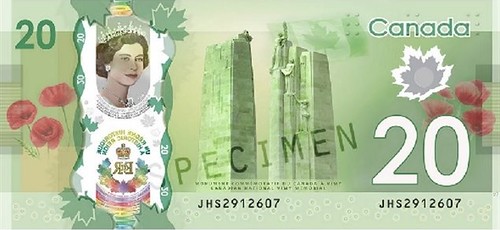
What do you get when you put topless women and an image that looks like the Twin Towers on a Canadian $20 dollar bill? A lot of controversy.
The newly redesigned $20 bill was unveiled by the Bank of Canada in Ottawa last week, according to the Daily Mail. The revamped bill — the most counterfeited Canadian tender in circulation — is manufactured from a high-tech polymer and boasts a difficult-to-copy design that’s supposed to make it much more difficult to produce.
If only someone had taken a closer look at what the new design actually was. While it features a portrait of Queen Elizabeth II (Canada is a commonwealth country, don’t forget), it also carries a reproduction of the National Vimy Memorial. There are a couple problems here: for one thing, the Vimy Memorial, created to honor Canadian servicemembers who lost their lives during World War I, is not the most recognizable of national symbols. “I’ve never seen this monument, ever,” said one Vancouver participant in a Bank of Canada focus group on the bill.
For another, it also happens to be in France: the memorial rises 120 feet over the Douai Plain, near the battlefields where more than 7,000 Canadian soldiers lost their lives.
But the biggest problem may be that the Vimy’s double-columned design, draped with semi-clad classical figures, manages to evoke both the ill-fated Twin Towers of New York City and softcore porn. “When you quickly glance at it, and if I didn’t know any better, it looks like the Twin Towers,” one focus group participant said, according to documents from Toronto market research firm The Strategic Council obtained by Canadian broadcaster CTV News. Critics called special attention to the figures draped revealingly across the top of the monument, meant to represent Justice and Peace. “It’s too pornographic,” a cash handler in Toronto told researchers. “What is the woman on the top holding?”
To read the complete article, see:
Dirty Money: Is Canada’s New $20 Bill
‘Pornographic’? (http://newsfeed.time.com/2012/05/11/dirty-money-is-canadas-new-20-bill-pornographic/)
For more information on the Memorial, see:
Canadian National Vimy
Memorial : Introduction (www.veterans.gc.ca/eng/remembrance/memorials/overseas/first-world-war/france/vimy/Introduction)
To read the earlier E-Sylum article, see:
BANK OF CANADA ISSUES ELIZABETH COMMEMORATIVE
(www.coinbooks.org/esylum_v18n37a28.html)
BOMBAY HOOK WILDLIFE REFUGE QUARTER LAUNCH
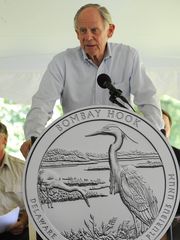 Delaware’s newest specialty quarter showcases Bombay Hook National Wildlife Refuge and two wading birds that are often spotted there and at
other coastal wetland habitats throughout the state.
Delaware’s newest specialty quarter showcases Bombay Hook National Wildlife Refuge and two wading birds that are often spotted there and at
other coastal wetland habitats throughout the state.
The refuge quarter, launched Friday, at Bombay Hook National Wildlife Refuge near Smyrna, is the 29th of 56 released as part of the America the Beautiful Quarters Program.
The quarters are released in the order that properties became national parks or holdings. The refuge, established in 1937, includes one of the largest tidal salt marshes in the region. It attracts millions of migratory ducks and geese in the fall. But it is also an important stopover for shorebirds, neo-tropical songbirds and wading birds like great blue herons and great egrets – the two birds featured on the reverse of the coin. In the fall, alone, more than a million visitors come to the refuge to see the massive assemblage of snow geese, Canada geese and ducks.
“It really is a tremendous honor for the Fish & Wildlife Service to have a national wildlife refuge in this America the Beautiful quarter series,” said Jim Kurth, deputy director for operations for the Fish & Wildlife Service. “Bombay Hook is a great national wildlife refuge.”
While the quarter features the great blue heron and great egret, “those are only two of the 276 other species of birds that come to this national wildlife refuge,” Kurth said. “That’s why its an internationally important birding site.”
Al Rizzo, U.S. Fish and Wildlife project leader for the Coastal Delaware national refuge complex in Delaware that includes both Bombay Hook and Prime Hook refuge, said he hoped that the launch of the new quarter would spark people’s interest in the refuge and give them “an appreciation for the jewels that we have in the state of Delaware.”
J. Marc Landry, plant manager at the U.S. Mint in Philadelphia, said that along with the quarters, lesson plans for each coin release in this program and others are available to help teach “a new generation” about national sites. The America the Beautiful quarter plans, depending on the location, provide lessons in history, geography, habitat and natural resources, he said.
The Bombay Hook quarter is special for mint employees in Philadelphia, Landry said. The first of the coins were struck at the Philadelphia site on July 28, he said. The mint is 67 miles north of Bombay Hook so many of the employees who work there are familiar with the refuge and some live in Delaware, Landry said. The Denver mint struck its first Bombay Hook quarters on Aug. 10.
“This quarter carries a special beauty to us,” he said.

People lined up to purchase Bombay Hook quarters
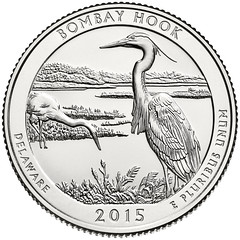 The quarter's reverse (tails side) design features a great blue heron in the foreground and a great egret in the background. The
reverse was designed by United States Mint Artistic Infusion Program artist Joel Iskowitz and engraved by United States Mint Sculptor-Engraver Phebe
Hemphill.
The quarter's reverse (tails side) design features a great blue heron in the foreground and a great egret in the background. The
reverse was designed by United States Mint Artistic Infusion Program artist Joel Iskowitz and engraved by United States Mint Sculptor-Engraver Phebe
Hemphill.
Local school-aged children attended the ceremony, which took place at the Bombay Hook National Wildlife Refuge Visitor Center. Additional participants included U.S. Senators Tom Carper and Chris Coons; U.S. Fish and Wildlife Service Deputy Director Jim Kurth; Coastal Delaware National Wildlife Refuge Complex Project Leader Al Rizzo; Bombay Hook National Wildlife Refuge Manager Oscar Reed; and former Governor and U.S. Representative for Delaware Michael Castle. The event culminated in the Mint’s United States Mint – Connecting America through Coins traditional coin exchange of newly-minted rolls of Bombay Hook National Wildlife Refuge quarters.
To read the complete article, see:
New Delaware quarter showcases Bombay Hook, birds
(www.delawareonline.com/story/news/local/2015/09/18/new-delaware-quarter-showcases-bombay-hook-national-wildlife-refuge/72402626/)
To read the earlier E-Sylum article, see:
2015 AMERICA THE BEAUTIFUL COIN DESIGNS
(www.coinbooks.org/esylum_v17n07a22.html)

THE H.L. HUNLEY LOOKS LIKE A SUBMARINE AGAIN
For more than a century, the H.L. Hunley rested at the bottom of the ocean just outside Charleston harbor, its crew entombed, its hull gradually encased in hardening encrustations.
When it was raised 15 years ago off South Carolina, it looked more like a barnacled sea monster than the world’s first combat submarine to sink an enemy warship. The Hunley sank in battle during the winter of 1864.
The remains of its eight sailors were removed in 2001, but research has continued and Thursday a conservation team announced that experts have now removed more than half a ton of the encrustations.
The result: The Hunley has much of the look and menace of a modern sub, and is clearly the ancestor of the U-boat and the nuclear submarine of today.
On the night of Feb. 17, 1864, the crude Confederate vessel — which was made from a boiler, had no extra air supply and was powered by a hand crank — rammed a torpedo into a Union warship anchored off Charleston.
The Yankee ship, the USS Housatonic, went down, but so did the 14-ton Hunley with its captain and crew.
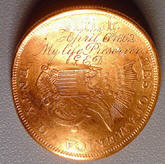 "Lt. George Dixon, the sub's commander, carried with him a special $20 gold piece. "Early in the war, in Mobile, Ala.,
Queenie Bennett (Dixon’s fiancée) gave him a $20 gold piece. While at Shiloh, a Union bullet penetrated his trouser pocket and struck the coin. The
impact left the gold piece shaped like a bell, with the bullet embedded in it. If it wasn’t for that coin, he probably would have died on the
battlefield–and the Hunley might never have made history. He would carry that coin the rest of his life..."
"Lt. George Dixon, the sub's commander, carried with him a special $20 gold piece. "Early in the war, in Mobile, Ala.,
Queenie Bennett (Dixon’s fiancée) gave him a $20 gold piece. While at Shiloh, a Union bullet penetrated his trouser pocket and struck the coin. The
impact left the gold piece shaped like a bell, with the bullet embedded in it. If it wasn’t for that coin, he probably would have died on the
battlefield–and the Hunley might never have made history. He would carry that coin the rest of his life..."
A May 25, 2001 article in The Charlotte (N.C.) Observer reports that "Archaeologists digging mud and human remains from the Confederate submarine Hunley have found the commander's lucky gold coin, still sparkling from a century-old love that will not tarnish.
Historians thought that Lt. George Dixon might have carried the coin, a gift from his fiancee, on the night the Hunley became the first submarine in history to sink an enemy ship. But not until 9:30 Wednesday night, four months into the excavation of the sub, did they confirm that the coin was on board.
The coin that senior archaeologist Maria Jacobsen pulled out of the muck of the Hunley Wednesday bears the cursive engraving: "Shiloh / April 6, 1862 / My life Preserver / G.E.D."
"Artifacts are very important, but as archaeologists we want to know the story behind the artifacts," Jacobsen said Thursday in Charleston, where she and other archaeologists are painstakingly excavating the sub's interior. "As soon as I touched it through the mud I knew it was the coin.... That was a rare, teary moment for me. It was that message from the past we're always looking for."
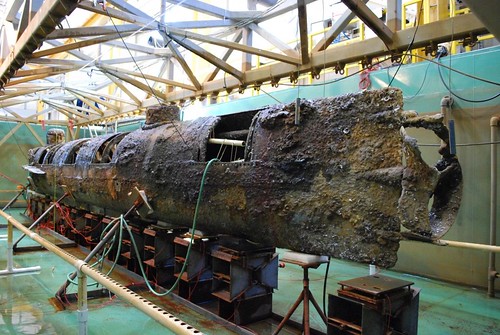
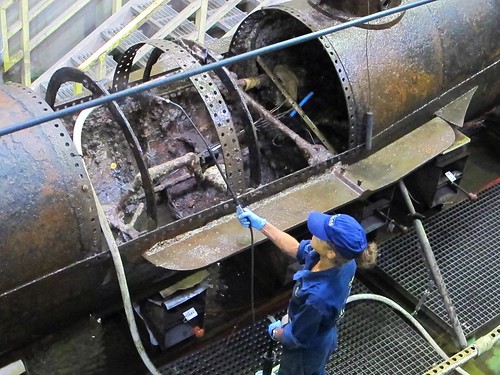
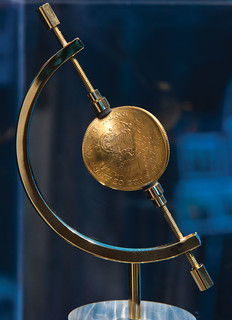 For more information, see:
For more information, see:
www.hunley.org
“I’ve got the coin.” (www.clemson.edu/glimpse/?p=1147)
LT. Dixon's Gold Coin Replica
(http://hunleywebstore.com/mm5/merchant.mvc?Store_Code=FOTH&
Screen=PROD&Product_Code=3)
To read the complete articles, see:
Cleaned of encrustations, the H.L. Hunley becomes a real submarine
(www.washingtonpost.com/local/cleaned-of-encrustations-the-css-hunley-becomes-a-real-submarine/2015/09/17/f1809ff4-5d46-11e5-9757-e49273f05f65_story.html)
Hull of first sub in history to sink enemy warship revealed
(www.washingtonpost.com/national/hull-of-first-sub-in-history-to-sink-enemy-warship-revealed/2015/09/17/cd0bd2c4-5d6e-11e5-8475-781cc9851652_story.html)
To read the earlier E-Sylum articles, see:
HUNLEY SUB LUCKY GOLD COIN FOUND (www.coinbooks.org/esylum_v04n22a05.html)
HUNLEY CREW LAID TO REST (www.coinbooks.org/esylum_v07n17a05.html) 150TH ANNIVERSARY OF THE SINKING OF THE HUNLEY
(www.coinbooks.org/esylum_v17n08a14.html)
SOME RECENT COIN DESIGNS: SEPTEMBER 20, 2015
Vatican City 5 Euro
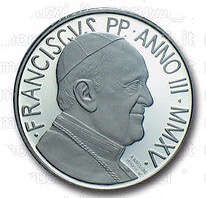
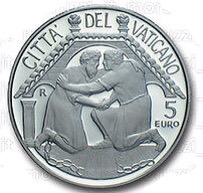
Netherlands 2 Euro Coin on the European Union Flag
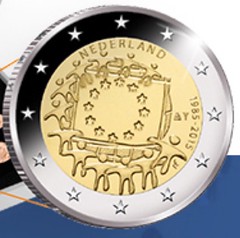
Ukraine Coin on Kyiv-Mohyla Academy
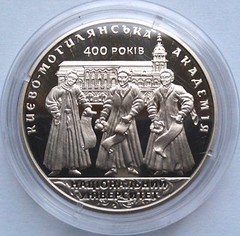
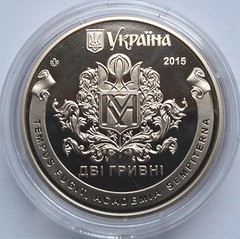
Ukraine Coin on Ivan Karpenko-Karyi
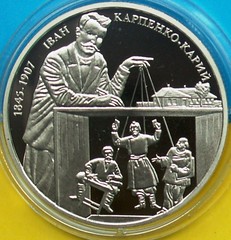
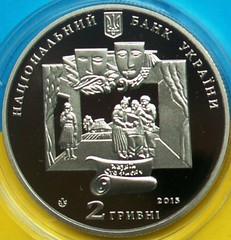
2015 Austrian Euro Coins
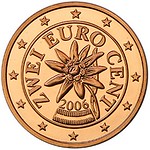
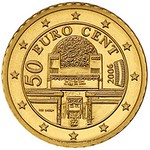
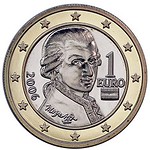
2 cent, 50 cent, One Euro coins
To read the complete article, see:
2015 Austrian Euro Coin Proof Set
(world.mintnewsblog.com/2015/09/2015-austrian-euro-coin-proof-set/)
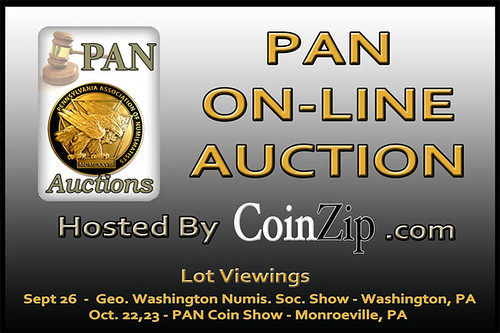
ARTICLE PROFILES BROTHERS IN CANADIAN MINT'S DESIGN CONTEST
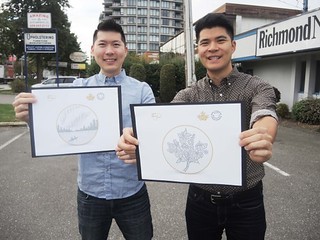 The motivations behind Timothy and Stephen Hsia’s entry into the Royal Canadian Mint’s national coin design contest are many.
The motivations behind Timothy and Stephen Hsia’s entry into the Royal Canadian Mint’s national coin design contest are many.
The Richmond brothers — Timothy, 30, a family doctor at Aberdeen Health Centre, and Stephen, 29, a commercial litigation lawyer — were inspired by the Northern Lights and Canadian nature respectively with their innovative designs, which have earned them each a one-in-five chance of national fame out of 10,000 hopefuls.
But it is the memory of the pair’s late grandfather, Philip Hsia, who would have been 100 in two years’ time, that is the real inspiration behind the brothers’ success, not only in becoming finalists in the mint’s public voting contest, but in life, in general.
“Our grandpa was our hero,” said Stephen. “He grew up in poverty and ran away from home at age 11 with nothing but three coins that his mother entrusted with him.
“Over his lifetime, he excelled academically, qualified for the Olympics in track and field, flew bombers in the Second World War with the Flying Tigers, and became a successful businessman in Hong Kong.
In 1968, their grandfather immigrated to Richmond, which he called home until his death in 2010, before which he was a strong advocate about giving back to the community and could be seen jogging around the Minoru track in the early mornings.
“When Tim and I were growing up, Grandpa was an avid coin collector and would give each of his grandchildren a gold coin on their birthdays,” said Stephen.
“We appreciated the gesture and over time realized that Grandpa had effectively made us coin collectors ourselves. We were inspired by the beautiful designs of Grandpa’s coins and we dedicate our coin designs to him.”
Both Tim and Stephen, Princeton University graduates, who live at home with their parents near Steveston Highway and Gilbert Road, are avid amateur artists and designers in their free time and have been drawing and sketching as long as they can remember.
This is the first time, however, they’ve entered a competition such as the national mint’s, which is being run to find the design for a commemorative coin to celebrate Canada’s 150th anniversary of Confederation in 2017.
Timothy’s “Dance of the Spirits” entry is one of five finalists in the “Our Wonders” category, while Stephen’s “Confederation Bouquet” has a great chance in the “Our Character” division.
And with the general 150th theme in mind, Stephen’s design incorporates the official flowers of the nation’s 13 provinces and territories.
To read the complete article, see:
Richmond brothers
finalists in Canadian mint's design contest
(www.richmond-news.com/community/richmond-brothers-finalists-in-canadian-mint-s-design-contest-1.2062821)
TREASURE HUNTING IS THE SCHMITT FAMILY BUSINESS
 Not everyone wants to go into the family business. The world is littered with the children of tailors or lawyers or insurance agents who
want to break free. But what if your father is a treasure hunter?
Not everyone wants to go into the family business. The world is littered with the children of tailors or lawyers or insurance agents who
want to break free. But what if your father is a treasure hunter?
This is not a hypothetical for Eric Schmitt, who grew up diving for treasure with his dad off the coast of Florida.
“He was in the right place at the right time,” says Schmitt.
The right place was Florida’s Treasure Coast, a region off the state’s Atlantic shore where a fleet of Spanish ships met their fate during a massive hurricane in 1715. Schmitt’s father, Rick, got his start during the 1960s, when the fleet was first uncovered. During those early days, divers were “bringing up a lot of treasure—tons of it”.
Eleven ships sank, dragging with them caches of gold, silver, jewelry and other artifacts to the ocean floor. Modern-day treasure hunters weren’t the first to get the idea that they should plumb the sunken vessels for riches—pirates once made their way to the crash site in search of goods. Of the eleven ships, six have been uncovered. This past July marked the 300th anniversary of the initial sinking, and it was commemorated with art shows, book signings, a historical symposium and even a Pirate Festival.
Schmitt and his father started working together formally in 1999, and that version of the business lasted until 2004. By then, the dramatic Florida weather had taken its toll on the Schmitts. One of the worst hurricanes in years arrived, and their boat was wrecked in the storm. Schmitt went to college and graduated but never escaped the pull of treasure hunting. They reconvened the business in 2011 and have been doing it ever since.
And this isn’t just a father and son operation; Schmitt’s wife, mother and sister are all crew members. While Schmitt is underwater, his wife Lindsay is the “first mate,” keeping detailed GPS coordinates and other records. His younger sister spends her summer breaks from teaching fourth grade diving for treasure. A glance at the company’s Facebook page reveals what looks like an idyllic anti-office: Astonishingly blue water, puffy clouds, and grinning members of the Schmitt clan emerging from the water with everything from coins to shoe soles.
The Schmitt’s have embraced the pirate image. Their business is called Booty Salvage and their salvage vessel is Aarr Booty. “Booty Salvage,” declares their company swag. “Leaving no bottom untouched.” The motto is accompanied by a grinning skull, tongue wagging. But that is pretty much where the pirate comparison ends. Treasure hunting is not a lark for anyone with a metal detector; Florida regulates such practices and the Schmitts have permits that allow them to excavate shipwrecks. The Schmitts are required to cooperate with archaeologists and compensate the state with up to 20 percent of their hauls, typically in objects considered historically significant.
For the Schmitts, treasure hunting high season stretches from June to August. May and September are transition months, and the sea is usually too rough the rest of the year. During high season, the Schmitt’s are on the water almost every day, working mostly a 30-mile expanse where the 1715 wrecks reside, and still offer up long sunken treasure.
“Thirty miles of ocean is pretty big, it can hide a lot of stuff,” says Schmitt.
The Schmitt’s have found remarkable things over the years, such as a delicate gold filigree box and strands of gold necklaces, but treasure hunting is slow and steady work; not every day brings an impressive haul.
 But in 2015, the Schmitt’s made a truly historic discovery that earned them international media attention. They unearthed a cache of gold
coins worth more than $1 million. Three hundred years ago, Schmitt explains, it was common to melt coins down and reconfigure them to stay current
with the changing face of money, eliminating the old currency from circulation. Every coin found is one of the rarest in the world, he says.
But in 2015, the Schmitt’s made a truly historic discovery that earned them international media attention. They unearthed a cache of gold
coins worth more than $1 million. Three hundred years ago, Schmitt explains, it was common to melt coins down and reconfigure them to stay current
with the changing face of money, eliminating the old currency from circulation. Every coin found is one of the rarest in the world, he says.
“It’s all day long, you’re out in the sun, you’re rocking on boat, you’re diving all day long with a weighted belt,” he says. “We worked hard and it’s kind of like winning the Super Bowl—you put in the same amount of work every year and it finally happens.”
To read the complete article, see:
WHEN TREASURE HUNTING IS THE FAMILY
BUSINESS (www.atlasobscura.com/articles/when-treasure-hunting-is-the-family-business)
THE BOOK BAZARRE
SELECTIONS FROM THE ERIC P. NEWMAN COLLECTION PART VII
Lot 18001: 1813 Puerto Rico 8 Reales
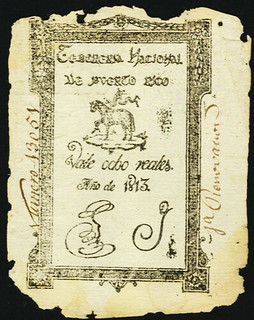

Puerto Rico - Tesoreria Nacional de Puerto Rico 8 Reales 1813 Pick 2a. PCGS Very Fine 30 Apparent.
Appropriately, Eric P. Newman collected Puerto Rico and Danish West Indies notes alongside his other Territorial and Western notes, due to their geo-political relationship with the United States. Puerto Rico was established as a Spanish Colony on Columbus' second voyage to the New World. (According to Smithsonian.com, the island was initially called San Juan Bautista by the Spanish.) A limited amount of paper currency was issued under Spanish auspices beginning in the early 19th century. Few of these earliest notes are known to collectors today.
To read the complete lot description, see:
Puerto Rico - Tesoreria Nacional de Puerto Rico 8 Reales 1813 Pick 2a.
(http://currency.ha.com/itm/world-currency/puerto-rico-tesoreria-nacional-de-puerto-rico-8-reales-1813-pick-2a-pcgs-very-fine-30-apparent/a/3539-18001.s)
Lot 18010: Quebec, George King 6 Coppers June 1, 1773

Canada - Quebec, PQ George King 6 Coppers June 1, 1773. Graham QC-200-10-04. PCGS Extremely Fine 40PPQ.
This is an interesting private note issued in Quebec, the earliest Canadian private scrip, shortly before the American Revolution. George King was a prominent shipbuilder in Quebec. At the time this note was issued, he was residing on Poor Street with his business partner Thomas McCord. Eventually they would use their ships to supply fur traders with alcohol and to facilitate the rum trade in the West Indies. Kings's notes are unlisted in the main Charlton reference and The Standard Catalog of World Paper Money. The notes were printed on sheets of six, in denominations of 3, 6, 12, 15, 20, and 24 coppers. Issue dates in 1772 and 1773 are observed. A small square note printed on laid paper. The texts are within intertwined vine bordering. The denomination block is across with outlined 6 COPPERS. A strong signature and wholly original paper are highlights.
To read the complete lot description, see:
Canada - Quebec, PQ George King 6 Coppers June 1, 1773. Graham QC-200-10-04.
(http://currency.ha.com/itm/world-currency/canada-quebec-pq-george-king-6-coppers-june-1-1773-graham-qc-200-10-04-pcgs-extremely-fine-40ppq/a/3539-18010.s)
Lot 18024: Connecticut July 12, 1709 3 Shillings Raised to 10
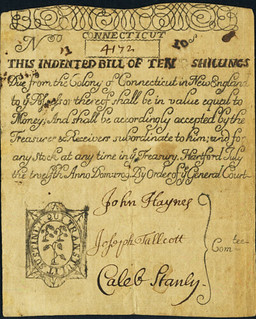
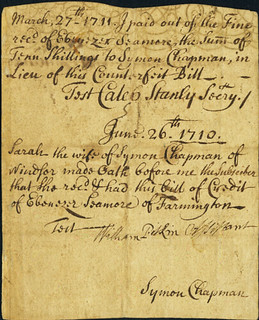
Colony of Connecticut July 12, 1709 3 Shillings Raised to 10 Shillings Fr. CT-3a. PCGS Very Fine 30 Apparent. This is an exceedingly rare, perhaps unique, and important early American currency note. The great Colonial note collectors from the 19th and early 20th centuries coveted the early "Tall" Bills of Credit. Legends such as Haseltine, Chapman, and F.C.C. Boyd held them in similar esteem to the rare Colonial coins they collected concurrently. Connecticut early bills are among the rarest New England issues. This is a genuine bill, with the denomination raised from 3 shillings to 10 shillings.
To read the complete lot description, see:
Colony of Connecticut July 12, 1709 3 Shillings Raised to 10 Shillings Fr. CT-3a.
(http://currency.ha.com/itm/colonial-notes/connecticut/colony-of-connecticut-july-12-1709-3-shillings-raised-to-10-shillings-fr-ct-3a-pcgs-very-fine-30-apparent/a/3539-18024.s)
Lot 18137: New York November 1, 1709 Lyon Dollars Issue
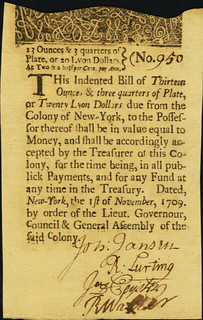

Colony of New York November 1, 1709 Lyon Dollars Issue 20 Lyon Dollars (13 Oz., 15 Dws.) Fr. NY-12. PCGS Choice About New 55 Apparent.
This is the rarest issue of 1709 notes, and it is fascinating. There are very few Lyon Dollar notes known, and we believe there are less than ten of all denominations in private hands (five impressions were in Boyd). Until our April 2015 Newman VI auction, our research had not found any instance of this denomination offered for public sale. Thus, this is one of the key New York Colonial Currency rarities. The issue was backed with 10,000 ounces of silver. Lyon dollars themselves were Dutch "Silver Dollars" which circulated worldwide as trade coins, just as the Spanish Milled Dollars. The rate of 5 shillings 6 pence was pegged to each (Lyon) dollar. There is also an interesting use of multiple denomination equivalents based on weight. There were only 300 notes authorized, and this highest denomination was not in Boyd. The style is similar to the other 1709 notes printed by Bradford, with typeset texts on the face and indent design at the top. There are four signatures, as required, like those appearing on the November 1, 1709 Shilling Issue note.
To read the complete lot description, see:
Colony of New York November 1, 1709 Lyon Dollars Issue 20 Lyon Dollars (13 Oz., 15 Dws.) Fr. NY-12.
(http://currency.ha.com/itm/colonial-notes/new-york/colony-of-new-york-november-1-1709-lyon-dollars-issue-20-lyon-dollars-13-oz-15-dws-fr-ny-12-pcgs-choice-about-new-55-a/a/3539-18137.s?)
Lot 18198: Rhode Island August 15, 1737 Redated 1738 2 Pounds
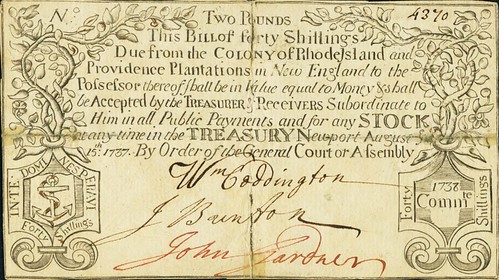
Rhode Island August 15, 1737 Redated 1738 2 Pounds Fr. RI-26b. PCGS Extremely Fine 40 Apparent.
This is another rarely seen, pre-1750 issue, and has an unusual horizontal format. The text is in the top center, and each end shows intricate vine details. At lower left, the Hope motto and anchor emblem. At the lower right is a denomination cartouche with the redate "1738" within. The ornate back has vine details, scroll lines at the left and the denomination in the center. This is a genuine note. The "tell" is the space between the top leaf tip and the outline of the (viewer's) left 40S on the back. On the counterfeit, the leaf is firmly attached.
To read the complete lot description, see:
Rhode Island August 15, 1737 Redated 1738 2 Pounds Fr. RI-26b.
(http://currency.ha.com/itm/colonial-notes/rhode-island/rhode-island-august-15-1737-redated-1738-2-pounds-fr-ri-26b-pcgs-extremely-fine-40-apparent/a/3539-18198.s)
Lot 18767: Confederate 1861 $500 Montgomery Note
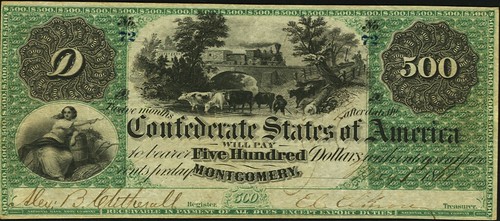
Confederate States of America - T2 1861 $500 Montgomery Issue PF-1, Cr. 2. PCGS Very Fine 35PPQ.
As with the $1000, only 607 notes printed, and approximately 120 exist today. This Newman-Green $500 Montgomery is another impressive example boasting tremendous eye appeal. Like the others notes from the series, this was an interest-bearing instrument paying "five cents per day," only up to "Twelve Months After Date." The $500 is arguably the most pleasing design, with inspired vignettes by the National Bank Note Company. At top center is the classic vignette, The Crossing, attributed to James D. Smillie, but not verified. A train crosses a stone bridge in the background, while a man on horseback drives cattle down a hill to the stream. Another worker, standing in the water and holding a cattle prod, finishes rolling up his pant legs. The vignette appears on several Obsolete banknotes from the period.
For many decades, collectors and scholars argued which Confederate type was the rarest. The current census records 137 notes in all grades. However, according to J. Wayne Hilton's detailed reference, he considers the T2 $500 as the rarest type based on auction appearances. With that in mind, perhaps the type has been underappreciated in recent decades. This is a gorgeous PPQ note. The color tinting and dark inked contrast are very attractive. The complete margins on all sides include three that are broad, with only the left close to the printed portion. This note apparently has never been publicly auctioned. However, it has been included on the Montgomery census, compiled by several scholars and dealers, for decades.
To read the complete lot description, see:
Confederate States of America - T2 1861 $500 Montgomery Issue
(http://currency.ha.com/itm/confederate-notes/1861-issues/confederate-states-of-america-t2-1861-500-montgomery-issue-pf-1-cr-2-pcgs-very-fine-35ppq/a/3539-18767.s)
EARLIEST MONEY USING THE DOLLAR AS A UNIT OF VALUE
To the Colony of Maryland goes the unique distinction of issuing and thus introducing the "dollar" to the world as an official unit of money. In 1767 Maryland changed monetary and numismatic history by printing and circulating paper money in a one dollar denomination and in multiples and fractions of a dollar. That dollar designation was thereafter adopted by the Continental Congress of the United Colonies in its paper money issues beginning in June 1775 and by the Congress of the United States in 1792 for coinage at its soon to be created Philadelphia Mint. The dollar was the unit authorized by several American states for paper money emissions beginning in 1776, in coinage for Sierra Leone in 1791 and for an 1804 Bank of England silver trade coin. The dollar today retains the universal status of being the best known monetary unit, being the basis of many present and past circulating coins and paper money of many countries during the 19th and 20th centuries.
The word dollar in 1767 was new only as an official monetary unit, but, as is well-known, was a translation into the English language of the Germanic word Thaler which was originally applied to a large 15th century silver coin of provincial Austria. The Scandinavian countries had translated Thaler into daler or Rixdaler for their currency unit. The word Dollar in the English language was the commercial reference to silver coins of the same general size as the Thaler, but became applicable primarily to Spanish-American silver coinage of the denomination of 8 reales because of the extensive use and circulation of that coinage throughout the world. The piece of 8 reales was more commonly called the Spanish Dollar and after 1732, that expression was often modified to Spanish Milled Dollar to reflect the introduction of edge milling and circular shape to such coinage. The Lyon Dollar or Lion Dollar was the English language expression referring to the large silver trade coin minted in 17th century Holland, bearing the emblem of a large rampant lion, but the Maryland Act of 1708 used the derisive term Dog Dollar in evaluating that coin.
For many years prior to 1767, the English words Dollar, Spanish Dollar and Spanish Milled Dollar were sometimes used as the special pricing and special accounting language in America, being a basis for bills of exchange calculations. This distinguished the transactions from money of account trading which related solely to transactions within a particular colony. Sterling was often used in accounting for the same purposes as the dollar.
Maryland's dollar paper money was payable in bills of exchange in London at the rate of 4 shillings 6 pence sterling for one dollar. The Maryland paper money of 1767 had denominations of $1/9th (6 pence sterling), $1/6th (9 pence sterling), $2/9ths (1 shilling sterling), $1/3rd (1 shilling 6 pence sterling), $1/2 (2 shillings 3 pence sterling), $2/3rds (3 shillings sterling) and $1, $2, $4, and $8 on the same basis. The sterling conversions to the dollar denominations were clearly printed on the paper money to aid in calculations, but there was no reference whatsoever to Maryland's money of account shillings or pence. Legal tender status was not given to the issue as that would have required a legal tender in Maryland's money of account system. The denial of legal tender status was most unusual in colonial issues but gave the offeree the opportunity to reject the money. The $1 and $2 denominations had illustrations of one or two Spanish dollars as part of their respective designs, just as the Chinese had used pictures of their bronze cash many centuries earlier. Maryland had also used secret marks on its paper money to deter counterfeiting and denominational alteration, but on the few known counterfeits, the secret marks were nevertheless carefully copied. Nature prints were put on the back of the paper money in a continuation of the use of that technique by the Green family of printers, using Benjamin Franklin's invention.
To read the complete article, see:
The Earliest Money Using the Dollar as a Unit of Value
(www.chicagocoinclub.org/projects/PiN/ted.html)
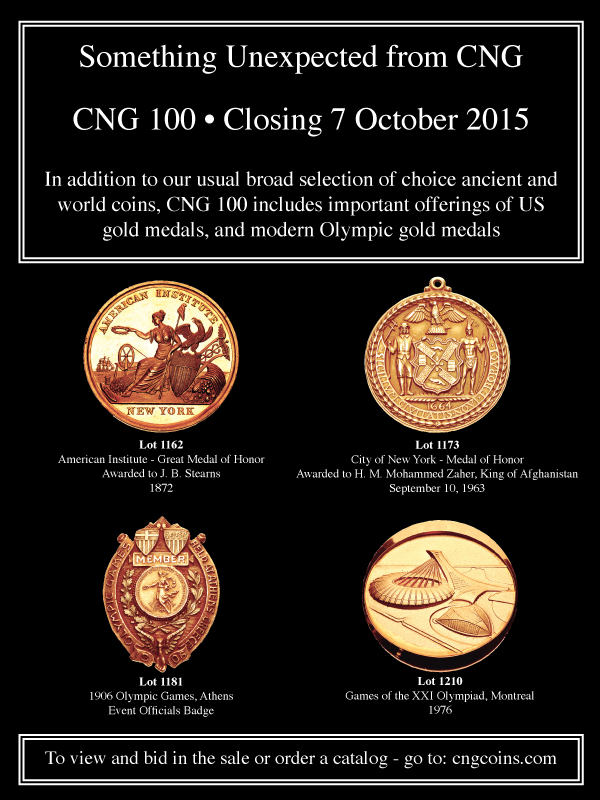
NEW EXHIBIT OF ST ALBANS ROMAN COIN HOARD
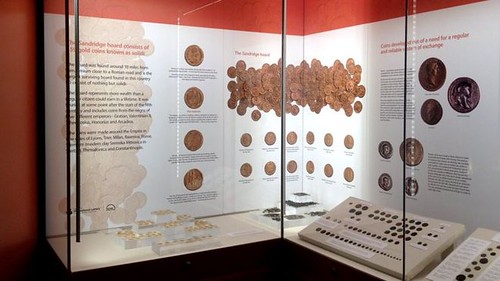
A hoard of Roman gold coins worth nearly £100,000 that was found in St Albans has gone on display at one of the city's museums.
The stash, found in October 2012, and believed to be one of the largest Roman gold coin hoards buried in the UK, can be seen at Verulamium Museum.
The 159 coins date from the final years of Roman rule in Britain in the 4th Century.
A museum spokesman said it was "quite a relief" they were finally on display.
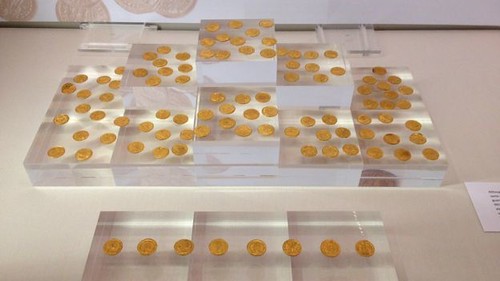
The coins, discovered on private land by Westley Carrington during his first metal-detecting outing, were declared treasure at an inquest in July 2013 and the value was decided by an independent committee at the British Museum.
Some had come from France, Germany and Greece, but they were mostly struck in the Italian cities of Milan and Ravenna, issued under the Emperors Gratian, Valentinian, Theodosius, Arcadius and Honorius.
A museum spokesman said it is thought the coins were minted between 404-408AD in Rome and - given their lack of wear and tear - buried just outside Verulamium just a few years after that.
David Thorold, a curator at the museum, said they were in "phenomenally good nick" and "had not been handled by many Roman individuals".
To read the complete article, see:
St Albans Roman gold coin hoard goes on display
(www.bbc.com/news/uk-england-beds-bucks-herts-34199524)
To read the earlier E-Sylum articles, see:
ROMAN GOLD COIN HOARD FOUND IN HERTFORDSHIRE
(www.coinbooks.org/esylum_v15n44a23.html)
MORE ON THE ST ALBANS ROMAN GOLD COIN HOARD
(www.coinbooks.org/esylum_v15n45a20.html)
BRITISH MUSEUM EXHIBITS ST ALBANS ROMAN COIN HOARD
(www.coinbooks.org/esylum_v15n51a18.html)
PROTECTING PAPER OBJECTS IN CORNERSTONES
While there are no coins involved, Len Augsburger forwarded this story from Washington University in St. Louis, adding:
Paper objects in cornerstones don’t always do so well……
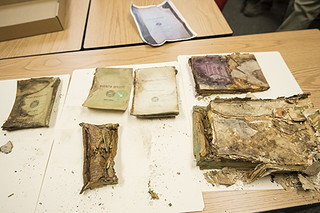 In 1902, Washington University in St. Louis leaders packed a cornerstone box with documents that paid tribute to the campus’ new gymnasium,
chronicled life at the university and anticipated the 1904 World’s Fair.
In 1902, Washington University in St. Louis leaders packed a cornerstone box with documents that paid tribute to the campus’ new gymnasium,
chronicled life at the university and anticipated the 1904 World’s Fair.
“Those materials show us who we were, and what we valued more than 100 years ago,” said Sonya Rooney, university archivist. “It’s a fascinating snapshot of the time.
Today, the university community is invited to create a time capsule of its own for the cornerstone of the Gary M. Sumers Recreation Center, scheduled to open in August 2016. Justin Carroll, associate vice chancellor for students, said the capsule will celebrate the central role the Athletics Complex plays on campus.
To protect the artifacts, Rooney will print documents on acid-free paper, place photographs in Mylar sleeves and include desiccant packs in the airtight capsule to control humidity.
If only Rooney’s predecessors had taken such care. On Oct. 25, 2014 — precisely 112 years after the gym’s cornerstone ceremony — Rooney, Carroll and others gathered to extract the original copper box from the gymnasium’s cornerstone. After workers drilled for hours, Rooney removed the lid of the copper box and found a brick of crumbling documents.
“We were disappointed so little had survived,” Carroll said. “Still, it was a very exciting, suspenseful morning. It felt like we were getting a rare peek into the past.”
Rooney also was disappointed, but not surprised. A crack in the cornerstone allowed water to seep in and out over time. Only four pages survived: a map of campus and three pages from a course catalog.
The good news was that Rooney not only had a list of the time capsule’s contents, the university archives also contained duplicates of many of the artifacts in the capsule.
To read the complete article, see:
A message to the future; a glimpse into the
past (https://news.wustl.edu/news/Pages/Sumers-Recreation-Center-Time-Capsule-2015.aspx)
FEATURED WEB SITE: NOTRE DAME COLONIAL CURRENCY
This week's Featured Web Site is the Colonial Currency section of the University of Notre Dame web site, written and maintained by Lou Jordan. I've illustrated a Virginia March 4, 1773 - Ashby Note.A catalog featuring hundreds of examples of colonial paper currency with supplementary sections on colonial lottery tickets and fiscal documents. Currency examples range from the New York issue of May 31, 1709 to the fractional currency privately emitted in the 1790's during the copper panic. Emissions are listed under the colony of issue followed by Continental Congress issues. There are a number of notes printed by Benjamin Franklin and several Massachusetts examples by Paul Revere. The site also includes explanatory essays on such topics as the first paper currency emission in the colonies, the relative value of local money in the colonies and land bank notes. The lottery section contains a ticket from the first government sponsored lottery in the colonies, the Massachusetts 1744-45 lottery.

www.coins.nd.edu/ColCurrency/
